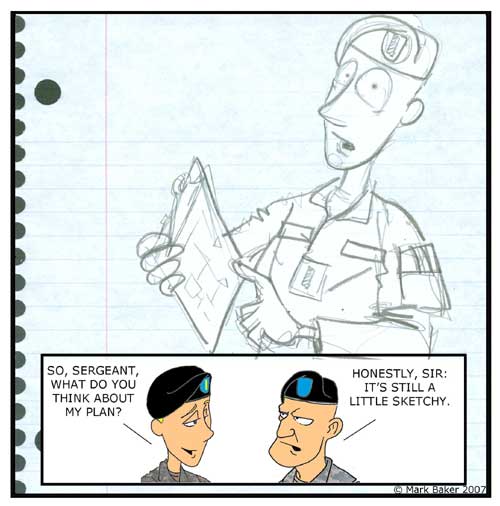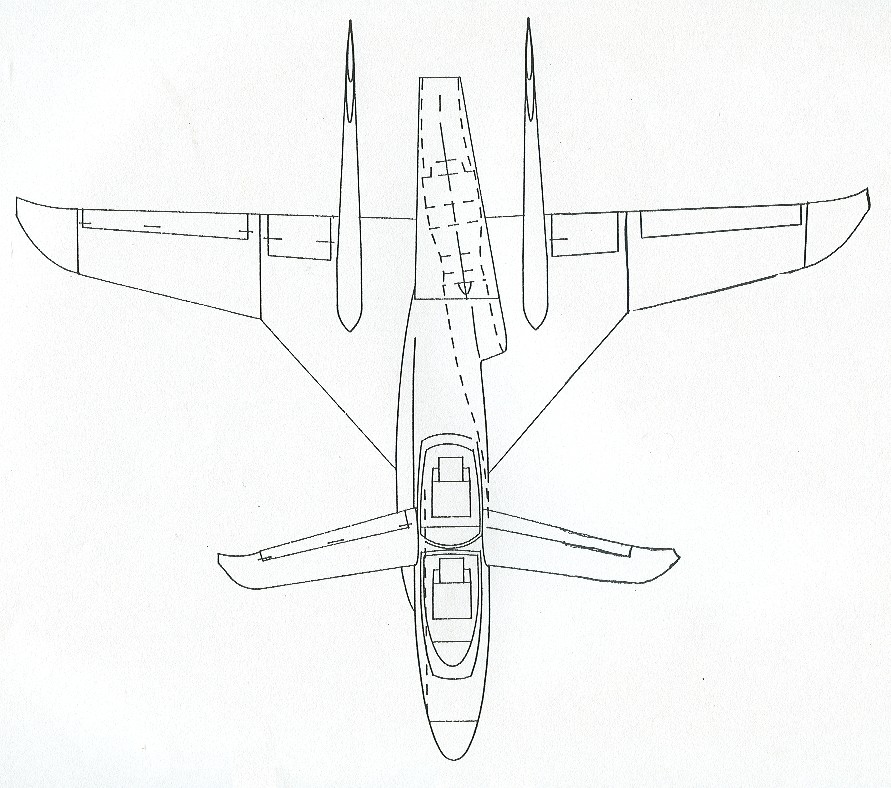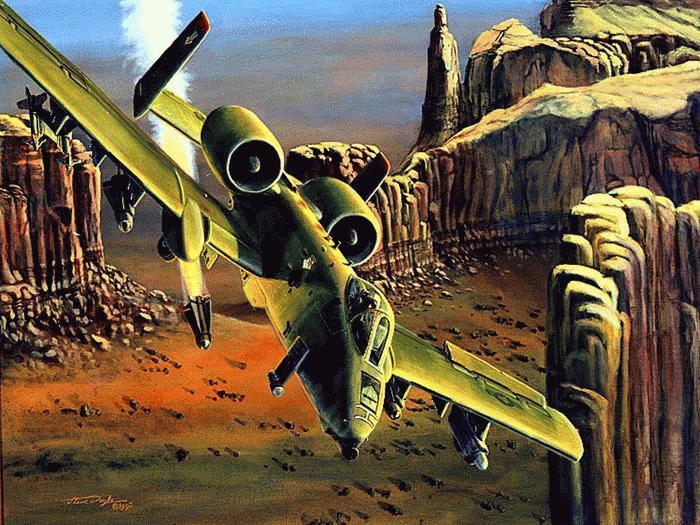
A-10 Warthogs operating from an Afghanistan Forward Operating Base!
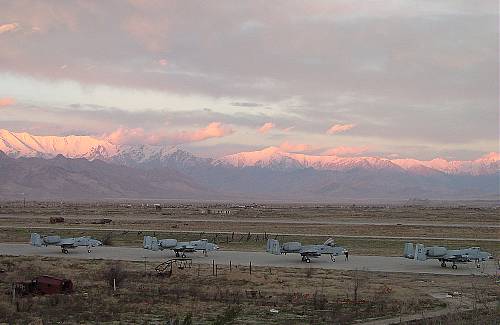
A-10 loaded to kill terrorists
Rainbow overhead signifies the good A-10s do to defend freedom
European Stars and Stripes
October 3, 2002
Blanketing Afghan skies
A-10 Pilots Have Crucial Roles
By Lisa Burgess, Stars and Stripes
BAGRAM AIR BASE, Afghanistan - Six mortars rained down at dawn last month near slumbering U.S. special operations Soldiers at a base in Lawara on the Afghanistan-Pakistan border.
But it was the enemy who got a rude awakening moments later when two U.S. Air Force A-10 Thunderbolts screamed out of the sky, ripping up the ridgeline with 30mm high-explosive ammunition, bombs and rockets. The Sept. 20 incident was a landmark for the pilots of the 354th Fighter Squadron from Davis-Monthan Air Force Base, Ariz. It was the first time these A-10 pilots returned to base "clean" - an Air Force term referring to a plane that has dropped its ordnance.
In an unstable land such as Afghanistan, every day the 354th's A-10s take to the air - and they go up virtually every day and most nights - is a day that could easily result in more clean jets.
Or jets that never come back.
"This is serious business out here," said Lt. Col. Tim Saffold, the 354th's commander.
Saffold allowed Stars and Stripes to spend almost an entire alert cycle with his squadron, offering interviews with more than a dozen airmen ranging from pilots to maintenance workers.
This is their story.
Alone and unique
The 354th has a unique role in Operation Enduring Freedom: It is the only U.S. fighter jet squadron based in Afghanistan.
The A-10 also plays a unique role in the Air Force's fighter inventory, because it is the only fighter designed to be an air-to-ground attack plane. The service's other primary fighters - F-15s and F-16s - are principally air-to-air fighters.
The A-10 is designed to get up close and personal if necessary, explained Lt. Col. Jeffrey Gringras, one of the A-10 pilots who flew the Lawara mission.
"We're up high to hide, but at some point, I have to put my visor up, roll up my sleeves, and get down with the guys on the ground," he said. The A-10's most formidable weapon at close range is its gun, which is mounted in the plane's nose.
"When you talk about the A-10, you've got to talk about the gun," Saffold said. "The entire plane is built around this 30mm weapon of choice, and it's very effective."
Gringras, a Huntsville, Ala., native, whose call sign is "Grass," has flown A-10s since 1985. His resumé includes 42 combat night sorties during Desert Storm, which he called "the culminating point in my flying training." His wingman on the Lawara mission was Capt. Bryan "Wheels" Wieland, who has spent four years on active duty.
The San Antonio native said the Lawara mission "was just like training." But once he got back to base and was met by Safford and other senior squadron members, the excitement kicked in.
"He didn't sit down for about three hours," Gringras said. As thrilling as the mission was, however, Wieland said he never forgets that U.S. forces are very close to the area where the ordnance is targeted. "Once the bombs go ... when I press the button, they're not coming back," Wieland said. "A top priority in this area of operations is 'no fratricide.'"
Wieland said it's not easy to think that some of his weapons may have killed people.
"I'm not bloodthirsty," he said. "I'll go out and kill them by the hundreds if I need to protect our guys on the ground. But if the [ground controller] tells me to scare them off by dropping flares, then I'm fine doing that." But Wieland said he knows what he signed up for.
"When you look at our job and our jet and what it's meant to do ... it's not tear gas or rubber bullets," he said. "It's killing and maiming."
On the front lines
For many pilots, flying a fighter jet is a lifelong dream.
A-10 pilot Capt. Greg Krino, whose call sign is "Winger," said he can't imagine any other life.
"I've known since I was a little kid that I wanted to fly upside down and blow things up," he said. "And I like that every time I go out here, it's a real mission."
Krino, a Long Beach, Calif., native, said he loves making all the decisions in his single-seat A-10.
"Just being in control of my own airplane and not having to listen to anyone else is really quite a treat," he said.
U.S. pilots in Single-Seat A-10s Attack British troops with "Friendly Fire"
 www.youtube.com/watch?v=RK10pqBpz8g
www.youtube.com/watch?v=RK10pqBpz8g
 www.youtube.com/watch?v=3THYnJ-PK6U
www.youtube.com/watch?v=3THYnJ-PK6U

www.youtube.com/watch?v=m4qgs1pHScA
The 354th is actually split in two, with many of the squadron's personnel and planes deployed to Ahmed Al Jaber Air Base in Kuwait in support of Operation Southern Watch.
For security reasons, Saffold declined to discuss the exact number of aircraft or pilots stationed here, saying, "It's enough to get the job done."
For safety reasons, the Air Force requires pilots to adhere to a rigidly defined crew rest schedule, which gives them more time to relax than the operations and maintenance crews, which are under no such restrictions. Those airmen have been putting in 12-hour days, seven-days-a-week, Saffold said.
One of the squadron's busiest people is Staff Sgt. Gavin Snyder, non-commissioned officer (NCO) in charge of air crew life support.
Snyder, a Lansford, Pa., native, is responsible for inspecting and maintaining everything pilots wear or use, including helmets, masks, survival vests and weapons.
Last week, Snyder was busy stripping and cleaning his pilots' M-9 pistols, a critical task in a country where high winds blow talcum-fine dirt into every nook and cranny.
For the 12-year Air Force veteran, Afghanistan is just another deployment. "I'm so used to doing this," he said. "My job is pretty straightforward."
"First-timers"
For squadron members on their first deployment, however, Bagram has been an eye-opener.
Senior Airman Mina Gomez, an information management journeyman from Corpus Christi, Texas, said she was "excited and a little nervous to go" to Bagram. Her first days in Afghanistan were less than auspicious.
"The first moment I set foot in this country, I got sick," she said.
Her diagnosis? "Bagram Bug," a mysterious sickness that seems to strike just about every service member here at least once. Symptoms vary, but usually include stomach cramps, diarrhea, vomiting and fever.
Many people also experience aching joints - and in Gomez's case, the pain was so severe the 20-year-old "had muscle spasms that put me in the hospital overnight."
The only saving grace "the Bug" has to offer is that - helped along by massive doses of the antibiotic Cipro - it is short-lived.
"Two days later, I was good to go," Gomez said.
The squadron's intelligence officer, who asked to be identified only as
"Schultz," is also on his "first real deployment."
"It's a lot better than I thought it would be," Schultz said.
"I packed like a turtle, so I could have all my essentials with me," but found many amenities already in place, such as cots, tents and showers.
"Come back home"
Capt. Mike Sommers, whose call sign is "Patch," is another member of the first-timer's club.
An A-10 pilot and the squadron's liaison with the air traffic control tower and radar personnel, Sommers said he couldn't be happier with his mission right now.
"I've never wanted to do anything else, since I was 4 years old," Sommers said.
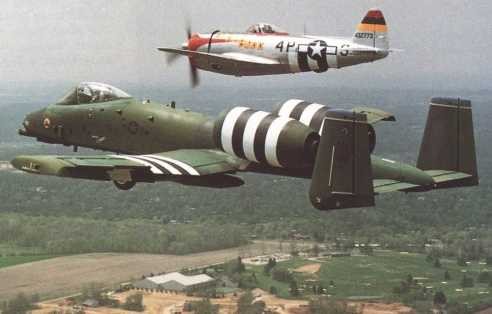
Sommers has a very special fan rooting for him back in his hometown of Tucson: his 86-year old step-grandfather, Neil King, who flew P-47 Thunderbolts in the Pacific during World War II.
"Since the A-10 is the 'Thunderbolt II,' he is all tickled pink that I wanted to be a pilot," Sommers said. "He even footed the bill for my private pilot's license in 1996."
Sommers often talks about aviation with King.
"He just loves that I'm flying the A-10. Oh, he's such a great guy," the young captain said.
Sommers said he made sure to ask King's advice before entering his first combat zone.
"The biggest thing he said was, 'Follow your training,'" Sommers said.
"The other thing he said was, 'Come back home.'"
Chicago Tribune
October 13, 2002
"Warthogs" Are The Workhorses Over Afghanistan
By Michael A. Lev, Tribune foreign correspondent
BAGRAM AIR BASE, Afghanistan -- As American troops led by the 82nd Airborne take over more of the hunt for Al Qaeda, an old friend of the infantry keeps watch above the desolate hills of Afghanistan.
The Air Force and its A-10 Thunderbolt II, also known as the tank-buster, are providing for conventional forces the same cover they gave the Army's Special Forces.
"We were right overhead and prepared to engage in seconds if required," said Capt. Stephen Cowart, an A-10 pilot who was scrambled recently from Bagram to the Pakistani border to provide cover for American troops heading into unfamiliar terrain.
"It was a successful mission because they were able to find what they were looking for, get in and get out, without any shooting," he noted. When a Special Operations base came under attack from rocket and small-arms fire Sept. 20, two A-10s responded by pummeling a ridgeline outside the camp, unloading four bombs and 500 rounds of intense cannon fire. The A-10, nicknamed the "Warthog" because of its shape, gets knocked sometimes within the military community for being slow and ugly. But ground troops are grateful to see it swoop into battle, and its pilots take pride in the fact that they dive right into the action in support of the infantry, sometimes attacking at altitudes as low as 100 feet.
"It comes in and lays waste, and if you're on the receiving end of that gun, boy you are going to wish you were in Kansas," said Lisa Burgess, a reporter with the military newspaper Stars and Stripes who has written about the A-10's role in Afghanistan.
The plane earned its reputation in the war with Iraq, where it was credited with causing half the Iraqi military losses, including tanks, Scuds and helicopters.
Especially deadly and accurate is the 30mm Gatling gun fitted into its nose cone. The plane is said to be built around the cannon, which can fire 3,900 rounds-a-minute.
On the infamous "highway of death" at the end of the 1991 Persian Gulf war, A-10s ripped up convoys of retreating Iraqi armament and other vehicles, recalled Major Douglas Delancey, a Paratrooper with the 82nd Airborne in Afghanistan.
"It was pretty much complete destruction," he said. "I remember destroyed vehicles, some still on fire, some barely recognizable. Some vehicles were trying to get around destroyed ones and they were destroyed too." The plane is protected by its maneuverability and sturdiness, including a titanium-encased cockpit. It has a range of 620 miles and a top speed of about 440 m.p.h.
Burgess said that because the U.S. dominates the skies, dogfights are less common and the role of close-air support has become crucial to the Air Force.
"In terms of the ready-to-respond guys, they are it in Afghanistan and they are very proud of that," she said.
The A-10 pilots and crews focus on their jobs but are also aware that their mission represents a direct response from the United States to the Sept. 11 attacks.
"Since they attacked the World Trade Center, we just have to stop that stuff from happening again," said Senior Airman Joshua Diericks, 22, an A-10 electronics specialist from Kewanne, Ill.
Weapons loaders have scrawled taunting messages directed at Osama bin Laden on bomb casings, and the base has organized a flag-carrying program, in which airmen can arrange to send a flag on an A-10 mission. "This is the first time this generation has felt its way of life could be risk. . . . I'm glad I can have a really significant impact," said pilot Cowart.
The fundamental misunderstanding of the Close Air Support (CAS) issue is the false assumption it has to be an "either/or" issue when its really an "and/or" issue. Its not either the U.S. Army controlling aircraft at the tactical level for CAS while forgetting about air supremacy ala 1942 North Africa, OR the AF controlling all aircraft and controlling the air but ignoring low-altitude air space control and CAS due to distant, vulnerable fixed-basing in the rear/centralization and anti-CAS bias (It ain't "sexy").
Its an "and/or" proposition today.
We have a strategic Air Force that controls the medium/high altitude air spaces. All we have to do is have at the same time a CAS "Cactus" Air Force that works in conjunction with the Army's attack helicopters AND ground targeting means to control the LOW altitude air spaces. The U.S. Army needs a decentralized, rapidly responsive CAS capability that operates from the same Forward Arming and Refueling Points (FARPs) that her OH-58D, AH-64 attack helicopters operate from. In fact, with the advent of the USAF C-17 delivering entire Army Brigade Combat Teams (BCTs) and requiring engineering support to maintain austere runways:
The official report on the use of unimproved runways proves that extensive and continuous engineer repairs are needed to enable the IRC to airland.
See sba-saaf~min.doc on bottom of web page
...and eliminate foreign object damage to jet engine intakes, the way is already "paved" for the Short Take-Off and Landing (STOL) capable A-10s to land and operate alongside Army attack helicopters to first Suppress Enemy Air Defenses, which in this case are primarily optically aimed shoulder fired man-portable air defense systems (MANPADs) and AAA cannon since the strategic USAF will have targeted and destroyed the enemy's integrated air defenses using radar-guided high altitude missiles and these are the only remaining threats.
Chuck Myers' Maneuver Air Support concept:
And the aircraft needed to do MAS:
The point is that currently, the centralized USAF control of all attack aircraft has harmed the national policy goals of the U.S. because it has not allowed USAF aircraft to effect CAS in conjunction with Army ground maneuver to clear the enemy's MANPADS and AAA to gain LOW-LEVEL AIR SUPREMACY. In the Gulf War, we did NOT gain low-level air space control and the result was we attacked from 10,000 to 15,000 feet excepting the sturdy armored A-10s and the lightning fast Tornado GR-1s. As time goes on, the bombing results are being found to be less and less positive.
www.fas.org/man/gao/nsiad97134/app_02.htm
"In sharp contrast to the readily detectable and locatable radar-guided SAMs (of which there were hundreds), neither IR SAMs nor optically aimed AAA emit any signal during their search and acquisition phase. Moreover, there were thousands of AAA sites throughout Iraq and the KTO and thousands of portable IR SAMs in the KTO. Except for the small number of fixed AAA sites that had, and actually used, radar, all IR SAMs and most AAA were very hard to find before they were actually used. As a result, even at the end of the war, pilots reported little if any diminution of AAA, and aircraft casualties from AAA and IR SAMs continued up to February 27--at the end of the war. As the Desert Storm 'Lessons Learned' section of the F-117 Tactical Employment manual reported (on p. 3-29), "The threats [to aircraft] were never attrited...AAA tended to be the highest threat."
The report continues:
"If we sum the losses and damage by cause, portable IR SAMs accounted for 31 percent of the total casualties, and AAA accounted for 38 percent--both more than twice the 16 percent of total casualties from radar SAMs. In effect, the data show that the anti-air threat assessed by many both before and during the war as the "high" threat system--radar SAMs--was responsible for just 16 percent of the coalition's total casualties. Conversely, the expected "low threat" AAA and man-portable IR SAMs, such as the 1970's vintage SA-7, which made up the majority of the Iraqi IR SAM force, accounted for 71 percent of total casualties (58 percent of total kills and 81 percent of total damage cases).The apparent preference for nighttime operations seems most likely related to maximizing aircraft survivability. As discussed later in this appendix, in Desert Storm, optically guided Iraqi IR SAMs and AAA were responsible for the largest number of aircraft casualties (losses and damage). Therefore, nighttime operations appear to have enhanced aircraft survivability."
Type of Coalition Aircraft Lost or Damaged and Attributed Cause
Radar Aircraft SAM IR SAM AAA Other Total
F-117 lost 0 0 0 0 0
F-117 damaged 0 0 0 0 0
F-111F lost 0 0 0 0 0
F-111F damaged 0 0 3 0 3
F-15E lost 1 0 1 0 2
F-15E damaged 0 0 0 0 0
A-6E lost 1 0 2 0 3
A-6E damaged 0 0 3 2 5
O/A-10 lost 0 6 0 0 6
O/A-10 damaged 0 3 11 0 14 F-16 lost 2 0 1 0 3
F-16 damaged 1 2 0 1 4
F/A-18 lost 0 0 0 2\a 2
F/A-18 damaged 0 7 1 0 8
B-52 lost 0 0 0 0 0
B-52 damaged 2 1 2 0 5
GR-1 lost\b 4 1 2 2 9
GR-1 damaged\b 1 0 0 0 1
Other lost\c 2 6 3 2 13
Other 0 2 4 2 8
damaged\c
Total lost 10 13 9 6 38
Total damaged 4 15 24 5 48
Total 14 28 33 11 86 casualties
TLAM lost\d 0 0 0 [DELETED] [DELETED]
\a One loss was attributed by GWAPS to a MIG-25; the second was stated as unknown.\b GR-1 data in this table include aircraft from the United Kingdom, Italy, and Saudi Arabia.
\c These rows include AC-130, EF-111, F-4G, F-14, F-15C, AV-8B, OV-10, A-4, F-5A, and Jaguar casualties. While these aircraft are not part of the focus of this report, they are included in this table as part of our discussion of the effectiveness of the Iraqi air defenses.
\38 Of those 21, 12 were A-10 casualties. A-10s were permitted to operate below 12,000 feet to as low as 4,000 to 7,000 feet on January 31 and thereafter. After January 31 is when 10 of the 12 medium- to low-altitude casualties occurred.
Desert Storm Aircraft Casualty Rates
Total Total Aircraft casualty Aircraft casualties strikes rate per strike
F-117 0 1,788 0
F-111F 3 2,802 0.0011
F-15E 2 2,124 0.0009
A-6E 8 2,617 0.0031
O/A-10 20 8,640\a 0.0023
F-16 7 11,698 0.0006
F/A-18 10 4,551 0.0022
B-52 5 1,706 0.0029
GR-1 10 1,317 0.0076
Total 65\b 37,243 0.0017
\a Precise A-10 strike data were not available. GWAPS recorded 8,640 A-10 sorties. Given the definition of a strike, the number of A-10 strikes may have been larger than the number of bombing sorties. If the number of A-10 strikes is larger than 8,640, then its per-strike aircraft casualty rate would be lower.The only notable drop in SEAD missions was after the first week of the air campaign. However, the number remained rather static during the following 5 weeks. This may reflect the fact that although the Iraqi IADS had been disrupted early in the air campaign, numerous SAM and AAA sites remained a threat, with autonomous radars, until the end of the war. The fact that there was not a consistent decline in SEAD missions, over time, suggests that simply destroying the integrated capabilities of the air defense system did not, unfortunately, eliminate its many component parts. (This is discussed further in app. VI.)"
In fact, our most recent enemies, the Serbs in Kosovo studied this weakness and created an asymmetric strategy to defeat our air power. Realizing we would not send Army ground maneuver forces into Kosovo, they knew that they could effectively hide from USAF bombing attacks from 12,000-15,000 feet using the rough terrain and hiding behind the civilian populace/buildings who after the aircraft flew away then could massacre and rape with impunity. So the Serbs turned their radars off. This saved their radar-guided missiles from USAF destruction and resulted in the AF not being able to fly low-level missions to acquire and destroy their Army without hitting innocent civilians. NATO strikes creating civilian casualties gave the enemy ammunition for 4th generation war psychological attacks on the legitimacy of the NATO's air campaign to "save" the Kosovars. With this still lethal air space under threat of enemy attack, the civilian policy makers were unwilling to send slower flying Army Apache helicopters from TF Hawk into Kosovo, further harming our ability to stop the Serb Army from killing people on the ground via low-altitude strike accuracy. We knew from Desert Storm that bombing accuracy would suffer at higher altitudes, the GAO reports:
"A series of steps must be performed to successfully attack a ground target from the air, especially when precision munitions are being used. For fixed targets that have been previously identified and located, the delivery aircraft must navigate to the geographic coordinates of the target and then pick it out from other possibilities, such as neighboring buildings or other objects. For mobile targets, the aircraft may have to search a broad area to find and identify the right candidates for attack. For either type of target, the pilot may need to determine that the target is a valid one--for example, the extent of previous damage, if any; for vehicles, what kind; whether the object is a decoy; and so forth".
Effects of High-Altitude Releases on IR Sensor Resolution. During the air campaign, the majority of bombs were released from aircraft flying above 12,000 to 15,000 feet because Brig. Gen. John M. Glosson ordered that restriction enforced after aircraft losses early in the air campaign during low-altitude munition deliveries.\17 Higher altitudes provided a relative sanctuary from most air defenses but resulted in a major compromise in terms of bomb accuracy and, ultimately, effectiveness.\18 For example, some F/A-18 pilots reported that bombing from high altitude sometimes meant a total slant range to the target of 7 miles. At this range, even large targets, like aircraft hangars, were "tiny" and hard to recognize. [DELETED]"
The lesson to be learned is that ground maneuver forces must be used to make air power effective since they can both flush out enemies from hiding and clear out enemy MANPADS and AAA and thus gain control of the low-altitude air space. Its a historical fact that ground forward air control creates the best CAS results. These ground forces can threaten the enemy's ADA radar guided weapons by ground attack to force them into the open for air strikes to hit them as they flee or destroy them by ground weapons. This Army ground force must be highly mobile and armored so it can be inserted by air as an Operational Maneuver Group (OMG) into the enemy's rear areas and be ground forward air controllers for USAF air strikes and enable lower-altitude air strikes by KILLING weapons Dead Enemy Air Defenses (DEAD) instead of just suppressing them (SEAD). The concept to insert Army OMGs in small Armored Fighting Vehicles called "Air-Mech-Strike" employs parachute airdrop from USAF aircraft or Army helicopter internal/external carry to deliver the forces into enemy territory.

The only current USAF aircraft that can survive at low altitudes against unsuppressed MANPADS and AAA gunfire is the A-10. To gain control of the low-level airspace to effect Air-Mech-Strike maneuver by Army ground OMGs USAF A-10s are needed to fly "top cover" bombing and strafing enemy MANPADS and AAA systems so Army helicopters and/or USAF transport aircraft can insert the force. Selected A-10s would have Electro Optical Counter Measure (EOCM) laser weapon systems to detect enemy optics and disable them with directed energy. This frees Army attack helicopters to expend their ordnance into the Landing or Drop Zones (LZs or Dzs) as the A-10s SEAD the air corridors in and out of the LZs/DZs. Prior to landing or dropping, Army helicopters lay down smokescreens with infared multi-spectral particles to defeat MANPADS and AAA, small-arms fire. Without A-10s for CAS and SEAD, Army helicopters will be hard pressed to cover all the likely threats in and out of the Assault Zone in a timely or efficient manner.
Once the Army Air-Mech-Strike force is on the ground, it can then proceed to maneuver on the enemy to DEAD and clear air corridors for USAF attacks to take place at lower, more effective altitudes as well as put a stop to the enemy trying to hide.
To effect the capability to seize control of the low-level air space, we need the USAF's A-10s in the Reserve and Air National Guard components to be assigned directly to the U.S. Army's Warfighting Corps Headquarters that do not currently have A-10s assigned. The XVIII Airborne Corps at Fort Bragg, NC has A-10s at adjacent Pope AFB to effect a close working relationship. But this must go further so we can fully exploit the Army's C4 ISR digitization of its ground forces and get the best CAS, SEAD and DEAD possible. What the Army finds by its ground sensors and recon scouts must be sent back to intelligence collection centers at Corps level with access to national imagery means (spy satellites) to insure they are actual targets and not decoys. What this means is the PHYSICAL Forward Operating Basing (FOB) of USAF A-10s alongside Army helicopters in the Assault Zone which USAF C-17s resupply along with the air-delivered BCTs. A well-thought through ground partnership of the Army and Air Force for CAS. We must actually practice the forward-basing of A-10s alongside Army helicopters, now in peacetime and quicken our combat engineers in the construction of austere runways for this purpose as we did in WWII with the famous "Cactus Air Force" which in the Pacific meant long-range P-38 fighters were available when we needed them to shoot down Admiral Yamato's bomber when we needed it. Had these P-38s been in far away Australia, Yamato would have lived to fight the U.S. with his tactical brilliance, prolonging the war and increasing U.S. casualties. In Europe, the P-47s ranging far and wide destroyed the German 2nd generation medium-to-heavyweight, Panzers and wheeled trucks stuck to the road nets, attacking them from the top where their armor was thinnest. The CAS of the U.S. Army Air Forces covered General Patton's flanks as he sped across France and Germany and relieved the siege at Bastogne. The forward basing of CAS allowed these tactical victories to occur.
On the otherhand, if we continue to operate USAF CAS from vulnerable-to-enemy-attack concrete runways hundreds of miles away from Army maneuver forces under rigid, centralized control without a habitual working relationship with the men on the ground, the enemy will continue to create asymmetric strategies and defeat us. Ad hoc CAS arrangements are neither responsive nor accurate. Ad hoc arrangements will not have the "ground truth" recon elements working closely together to insure that what the Army finds isn't destroyed by strikes at a high cost, only to be determined later they were decoys and dummies.
In contrast, consider an Army 82nd Airborne Air-Mech-Strike force inserting into enemy territory away from heavy air defenses to set up a FOB. In the Assault Zone (AZ), fuel and armaments are dropped by cargo parachutes. Hours later, they AZ is cleared for A-10s to land and refuel/re-arm from "fat cow" C-130s, C-17s or fuel blivets. As the AMS OMG moves out inside small AFVs, the A-10s are available for immediate CAS. As C-17s, C-130s STOL land, Army helicopters become available for CAS and tactical Air-Mech-Strike movements. The advantage here is that the A-10s do not have to fly back to a distant concrete runway in the rear ISB/TSB and become unavailable for Army CAS, they stay where they are needed.
Historically, CAS operations have a mixed record of success and failure in large-scale mobile wars. The most notable successes on a sustained basis were in World War II:
(1) The German cannon-firing JU-87 "Stukas" in mobile defense supporting the retreat of the German forces after the Stalingrad debacle.
(2) The Americans -- primarily in P-47s -- supporting the advance of the First and Third Armies across France in 1944. And General Kenney's "Cactus" Air Forces in the Southwest Pacific, particularly at the Paratrooper drop at Nadzab, New Guinea in 1943.
German CAS on the Eastern Front.
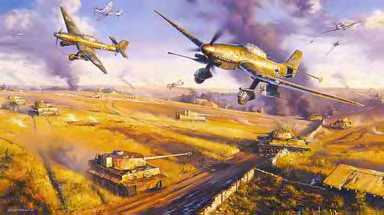
By 1943, the Germans were on the defensive, facing a Russian adversary who vastly outnumbered them in terms of men, tanks, artillery, airplanes, and motorized transport. Although the Germans always tried to maintain strong mobile reserves, and were willing to make extreme sacrifices of front line strength to do so, the numerical imbalance was so severe that they were always short of reserve forces. Consequently, the Germans were constantly countering deep penetrations, flank attacks and encirclements by Russian armored forces. Soviet doctrine was a direct descendent of these post-Stalingrad offensive armored operations against the Germans.
Although the anti-tank operations by the cannon equipped Stukas were too small in scale to affect the outcome on the Eastern Front, their effectiveness at the tactical level was most impressive. The unit commander, Col Hans Rudel ran up a personal score of over 500 confirmed tank kills (note: confirmation required that at least two people see the tank burn or explode) in over 2700 combat missions. Colonel Rudel, in a series of interviews, stressed the following aspects of successful CAS operations:
Target Acquisition
Rudel states repeatedly, and most emphatically, that this is the most difficult aspect of anti-tank operations. The pilot must be completely free to concentrate all his attention on tank hunting. Therefore, if the enemy has air-superiority over the battlefield, this distraction will make it impossible to find tanks. Enemy air defenses also make acquisition much more difficult. Most important, high speed "is poison" for finding tanks. Rudel was adamant that even though high speed might be desirable, under "no circumstances" should you sacrifice low speed performance to get high speed performance. His reason is simple: you can not find tanks at high speeds. (Comment: There are several reasons why Rudel's comments should be taken very seriously on this crucial point: He was the most experienced and effective combat pilot in the history of anti-tank warfare. Tanks look pretty much the same from the air today as they did in World War II. He was describing the difficulties of finding tank in the relatively open steppes of the Ukraine as opposed to a much more cluttered environment in Central Europe. Finally, he was relating to the top speed of the slow and clumbsy Stuka.)
Generally, you had to be within 400-500 meters slant range in order to determine if a carefully camouflaged moving vehicle was a tank, determining if the tank was an enemy often required that you get much closer. Recognition problems were toughest during breakthroughs because friendly and enemy tanks became intermingled; however, air defenses were weaker because the enemy had outrun his flak.
Command and Control
The German Army had no control over the Air Force, it could simply make a request for air support. Decisions were made at Air Division headquarters; however, usually by the time an order reached Rudel, conditions had changed and the order was no longer relevant. Rudel's reputation and stature were such that he had the freedom to choose his own area of operations so he normally adjusted his response to account for the changed conditions. In effect, this informal arrangement permitted Rudel to work directly with the ground commanders, and under this decentralized arrangement, he was usually able to achieve a response time of 15-20 minutes.
Luftwaffe liaison officers were placed in special tanks which had the guns stripped out and radios installed. These tanks were normally up front with the spearheads. Although they had no control authority, they were in constant contact with the Stukas, identifying targets to be attacked, or areas to be searched. When the Stukas were making identification passes, friendly ground troops would mark their positions using color coded flare pistols (German troops were not worried about giving away their positions because each side always knew where the other was located and Russian air power was generally ineffective.) Rudel stressed repeatedly that the key to good control was that the pilots must think of themselves as Soldiers. [EDITOR: why didn't the A-10s that fired on the British troops in 2003 first make an identification pass?]
Target Kill
As soon as Russian tank columns were attacked, they would get off the roads and try to hide or start weaving maneuvers to defeat the aim of the attacking Stukas. This is an important point because it illustrates the need to destroy the unit before it has time to disperse. This implies that the pilot must be able to re-attack quickly without losing sight of the target -- i.e., have a short turning radius -- and that the CAS force should attack in mass.
Survivability
The majority of losses occurred while the pilot rolled out and was tracking the target. It was essential to survival to minimize tracking time. Rudel would approach the target in hard erratic jinking maneuvers, roll out for one and a half seconds, fire, then resume the hard jinking. (Note: The HITVAL tests in the mid-1970s reaffirmed the importance of minimizing tracking time against the ZSU-23. The issue of tracking time is very important because PGMs such as the Maverick missile require in excess of 10 seconds to lock the guidance system on to the target. During this period the aircraft is flying a steady predictable flight path. Moreover, in a no-FEBA breakthrough scenario, the concept of standing off to survive loses its meaning because, although you may be standing off from an enemy tank, you may be directly over enemy air defenses.)
In general, Rudel felt attacks into static enemy positions with coordinated defenses resulted in unacceptable losses. For example, Rudel asserted that it was usually not worth the effort to attack bridges because they were quickly repaired and his losses were too heavy. He also avoided attacks on target-rich staging areas. However, after a breakthrough, the enemy forces would outrun their AAA and the enemy became much more vulnerable to air attack. (Note: This situation can be expected in the modern scenario because the delicate electronic systems and the requirements for inter-netting of missiles and guns make today's systems much more susceptible to breakdown or reduced effectiveness during rapid movement. On the other hand, in a static scenario, inter-netted modern weapons may be so lethal as to make air attack prohibitively expensive.)
American Army Air Corps/Air Force CAS on the Western Front.
Whereas Colonel Rudel's CAS experience is particularly enlightening at the tactical level of operations, the American Army Air Force experience in France and Germany yields important insights into the grand tactics (often referred to as the operational level of war) as well as the tactics of successful of CAS operations. The central aspect of this grand tactical dimension was the decision to integrate air and ground operations at the army level. This was done with the First and later the Third Army. Two Tactical Air Commands -- IX and XIX TACs -- integrated their operations with the operations of these armies. Here, we begin to see the potential of TACAIR as part of a combined arms team. One airman was responsible for this innovative application of TACAIR -- General Pete Quesada.
In the days immediately following the invasion of France, air support of the ground forces suffered from excessive response times and unproductive results. The leadership of the Army Air Corps (later Army Air Force) insisted on channeling requests from the beachhead back through headquarters in England. Apart from the delays, this system permitted little coordination of ground and air planning. The Air Corps' leadership centralized decision making in England because they believed, incorrectly as it turned out, that support of the ground forces would be an unnecessary diversion of resources away from the independent war-winning role of strategic bombing of German industry.
Quesada demonstrated an un-dogmatic willingness to decentralize the command relationships in response to the needs of the ground battle. He moved his headquarters near to General Omar Bradley's, the commander of the First Army; and established a close personal relationship with Bradley. He persuaded Bradley to put high frequency aircraft radios into special tanks and to place these tanks at the spearheads of the divisional combat commands. Army officers were given the authority to call down their own air support. Quesada was a frequent visitor to the front to see what his units were achieving and to keep in touch with the realities of the ground battle. He also worked hard to keep the ground commanders up to date on the air situation. His pilots flew as many as five missions a day, living between the sorties in the same mud and discomfort as the ground troops. When Third Army was activated, Gen Weyland, Commander of XIX TAC, patterned his operations after Quesada's. The following features of the CAS operations stand out:
Command, Control, and Reconnaissance
Each of the advancing tank columns was covered at all times by four aircraft which maintained armed recce in advance of the column. Directing their attention to the terrain in front of the column, these aircraft were permitted to attack any target identified as enemy. The divisional combat command commander would monitor the aircraft radio channel to receive their recce information, and could request the flight to attack the targets immediately in front of him. Target requests requiring more strength would be passed through air support party channels, and the missions would be accomplished by aircraft on strip alert. Friendly tank columns would often display bright fluorescent panels to identify their positions (enemy air power posed less of a threat than the bombing of friendly troops). With these arrangements, the fighter-bombers could often attack enemy tanks or strong points within 100 meters of friendly positions.
Viewed from the grand tactical level, TACAIR served as a highly mobile recce/artillery force that was used to enhance ground force mobility. Perhaps the best example was the support of the Third Army; the fighter bombers served as a flank guard on Patton's right flank as he raced across France. It is clear from the memoirs of the German panzer commanders that they considered the fighter bombers to be the most effective anti-armor weapon employed by the Allies -- they felt this way because the constant pressure from the air destroyed their mobility.
Tactical Effectiveness
The following information was obtained from Colonel W. Yale, U.S. Army (Retired), former commander Combat Command "B" (CCB), 11th Armored Division, 3rd Army. It provides some detail of the tactical cooperation that can be achieved by superb informal relations between the air and ground forces.
"The night before an action, the CCB operations staff made up small maps of the next day's prospective action and marked them with code figures showing probable hostile positions. The maps were mounted on small cardboard panels (to make them easy to hold in the cockpit) and delivered to XIX TAC with the divisional call signs on them. CCB was always prepared to provide artillery support to suppress enemy air defenses just prior to an air strike. These factors contributed to a common outlook and the spirit of mutual support. Under these conditions, normal response times were between 10 and 20 minutes, and sometimes CAS was available in 5 minutes".
As far as Colonel Yale was concerned, XIX TAC ...
"won the war for me."
This anecdote is impressive because it comes from a World War II U.S. Army officer (who were well-known for their disdain of air power).
American CAS in Korea.
The effectiveness of CAS in the Korean War is still a contentious issue, in part, because we never had the opportunity to interview the North Korean and Chinese Soldiers on the receiving end of our CAS operations.
Notwithstanding the stunning successes achieved by decentralizing operations in the latter part of WWII, the Air Force reverted to earlier WW II practices and insisted on centralizing CAS decisions at the numbered air force level. Also in sharp contrast to WWII practices, the Air Force relied much more heavily on airborne FACs -- 95% of the AF CAS sorties were controlled by airborne FACs. The average response time for Air Force CAS sorties was 45 minutes, and generally bombs were dropped to within 3-4 miles of friendly troops.
In contrast to the Air Force in Japan, the marines initially made CAS decisions to the marine air wing (MAW) level. They also relied much more heavily on ground FACs -- 95% of marine CAS sorties were controlled by ground FACs because when they used airborne FACs in slow [unarmored] O-1E "Bird Dog" prop aircraft they [sometimes] got shot down and men were killed needlessly. Under these arrangements, they were able to achieve response times of 5-10 minutes and were able to bomb within 1600 yards of friendly troops. However, later in the war, marine air operations were centralized under Air Force control at the numbered air force level. Under this new arrangement marine response times increased to about 45 minutes.
During the desperate retreat of the 1st marine division from its encirclement near the Chosin Reservoir; the marines, in effect, reverted to decentralized control of CAS operations. Flying WWII piston-engined F-4U Corsairs, against little threat from enemy TACAIR thanks to USAF air superiority, and enemy Anti-Aircraft Artillery (AAA) the marines strafed and bombarded Chinese positions in the hills overlooking the line of the 1st Division's retreat. For an excellent review of this operation, see "Marine Air Covers The Breakout." Marine Corps Gazette. August 1951. pp. 21-27.
American CAS in Vietnam.
We knuckled under to AF politics in the early '60s losing fixed-wing aircraft capability under ground maneuver control. The boundaries should have been altitude/air space--not equipment type. The Army should be responsible for low-level airspace in their area operations (non-oxygen flight 10,000 feet and below) and the AF should control airspaces from 10,000 feet up--which is above MANPADS SAM range--to space and from ground level to space where the Army is not in control to execute ground warfare. The U.S. Army should be able to buy/use whatever aircraft types it damn well thinks is best to get the damn job done--and win wars and save men's lives.
U.S. Army should not repeat mistakes of Vietnam by relying on USAF for CAS, should get its own fixed-wing U/MCAS aircraft (bring back the OV-1 and make a dual option unmanned/unmanned RoboMohawk?) and make AH-1s into manned or unmanned "RoboCobras" and create a "Cactus AF" capability that operates from forward airstrips alongside Army helicopters and ground maneuver units. The AF should co-operate and get A-10s operating alongside, too.
1. Why did we build the OV-10 when we could have armed the OV-1 and supplied it to the USAF/gyrenes? Are they not both ordnance carrying and STOL capable? I realize the OV-10 could parachute drop a 4-man recon team and the OV-1 could not.
2. Wouldn't the armed OV-1 be just as effective as the larger USAF A-1E SkyRaiders and more so than unarmored fast-mover jets that couldn't see targets and bombed our men accidentally? If the AF thought it necessary to bring back the A-1s for CAS and helicopter armed escort, why not work together and have Army OV-1s, too? Looks like the Army used Mohawks for CAS despite assholes in the DOD/USAF (GO ARMY!).
3. Once the NVA got SA-7 MANPADs, wouldn't 300 mph OV-1s be better than helicopter gunships for CAS until countermeasures were developed?
http://www.ov-1.com/misc/AIRPOWER/article.html
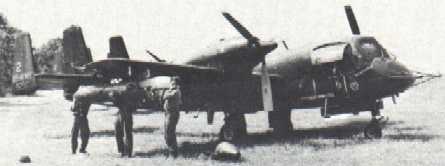
STOL CAPABLE
With its short, broad-chord wing, hydraulically operated flaps, leading edge slats and hydraulic speed brakes, the Mohawk was very much a STOL flying machine. More than half the wing span was bathed in the wash of the big, reversible-pitch propellers, and the wing incorporated a pair of hydraulically operated auxiliary ailerons that worked only when the flaps were down, for better low-speed control. Even loaded with test gear heavier than its intended reconnaissance fit, the YAO-1 could take off over a 50 ft. obstacle in about 900 ft. of runway and stop in just 300 ft.
In flight, the Mohawk had a design ceiling of 22,000 ft. and a top speed of about 320 mph. The big fuselage speed brakes helped the aircraft make ultra-short landings, and they enabled the Mohawk to drop quickly from moderate cruising altitudes to escape enemy fighters. Drawing from a Grumman Ironworks heritage, based on the 20-year production of dependable, robust fighter planes, the sturdy AO-1 was rated plus 5g and minus 1 1/2g, and could reportedly pull up to 7g without structural damage.
Ralph Donnell's masterful demonstration routines with the snappy Mohawk often included a near hover in a stiff wind. The new aircraft had a stalling speed of just 60 kt., and with flaps down a minimum turning radius of only 355 ft. at 1.6g. Flight testing of the YAO-1 turned up some slight flutter, quickly cured by smoothing the skin of the vertical tail. The successful test program led to a second $22 million contract for 35 production AO-1AFs, the first of which were delivered to the U.S. Army Aviation School at Ft. Rucker, Alabama, in mid-1960. STOL AO-1 had landing gear stressed for sink rates to 17 fpm and low pressure tires for soft, unprepared surfaces. Landings could be made in 300 to 500 ft.: takeoffs in 900 to 1,000 ft.
SURVIVABLE
Designed to take punishment and shoot back, Mohawk had 246 lbs. of crew armor including 1/4 in. thick aluminum cockpit floor and flak curtains. Photo shows .50 cal. machine gun pod being loaded on outboard wing pylon. Bulged cockpit canopy of Mohawk affords excellent downward view, and 1 in. thick, bullet-resistant (not bullet proof) windshield gave pilot and observer 22 degrees downward visibility over nose.
Mohawk ejection seat animated sequence
With the big propellers so close to the cockpit, and with the Mohawk destined to spend much of its time at low altitudes, conventional crew bail-outs were impossible. Grumman therefore provided the AO-1 with twin Martin-Baker ejection seats that could propel pilot and observer to safety from zero altitude at any air- speed greater than 100 kts. The transparent overhead panels also could be jettisoned, but normal ejection sequence blasted the crew right through the canopy. It took some time for Army ground and flight crews to learn how to maintain and use the new seats properly, but once procedures were established, the notoriously hard seats proved themselves lifesavers.
ARMED AND DEADLY TO THE ENEMY--NOT FRIENDLIES
The photo reconnaissance OV-1As were joined in 1963 by specially modified JOV-1Cs of the 11th Air Assault Division Based on the more powerful "C" version of the Mohawk, the armed reconnaissance JOV was stripped of the sophisticated infrared sensing gear that distinguished the "C" model and equipped with gunsight, dual controls, and two additional stores pylons. (All Mohawks had six wing hard-points but normally operated with only two or four pylons in place.) The aircraft represented the Army's attempt to exploit the attack capability of the OV-1, specifically in support of troop-carrying helicopters. It was to prove a successful and highly controversial experiment.
The ordnance-carrying potential of the OV-1 soon generated a long-running feud between the Army and the Air Force, and among factions of the Army aviation community itself. Tested with a varied collection of bombs, rockets, gunpods, and other stores, the OV-1 proved itself a nimble and potent weapons platform. It did, however, venture into what was considered the "operational realm of the Air Force" by providing fixed-wing air support for Army ground forces. The running battle over who should be responsible for such missions became so heated that at one point the Air Force demanded Grumman suppress company brochures stressing the attack potential of the OV-1.
Regardless of official policy, OV-1s in Southeast Asia often flew armed with a mix of rocket and gun pods. The rugged constitution of the aircraft proved a blessing for flight crews, particularly when Viet Cong forces were equipped with heavier weapons and learned how to use them against low-flying aircraft. One Mohawk returned to base with more than 90 holes in one wing, another with its empennage nearly severed by an anti-aircraft hit. One, nicknamed "Old Yeller" for all the zinc chromate dabbed over its battle patches, was mortally wounded after 900 combat hours. Unable to lower or shake one landing gear down, the pilot ordered the observer to eject, then followed himself. A Grumman technical representative later confirmed that the abandoned Mohawk obligingly crashed in a nearby scrapyard.
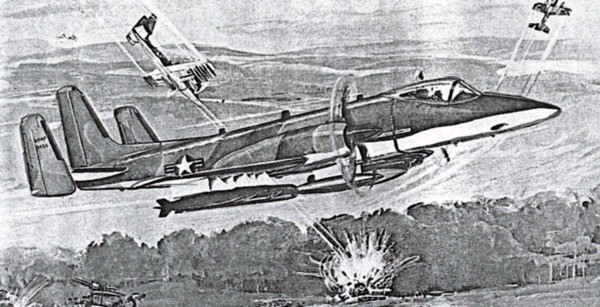
Grumman at one time proposed a single-seat attack version of the Mohawk with powerful T-55 engines and 30mm cannon in response to the Air Force AX competition. The production contract eventually went to the Fairchild Republic A-10. Another Mohawk derivative with an extended nose for extra seats and special electronics never advanced past the drawing board.
TARGET ACQUISITION: IT COULD FIND THE ENEMY
By night, photo reconnaissance OV-1s flew with two box-like dispensers mounted over the aft wing roots, each with 52 upward firing flares. Catastrophic accidents in which improperly loaded flares fired down and detonated the entire package led to the introduction of a more effective strobe light pod that could generate up to 300 powerful flashes a flight, one every 3 seconds.
Of far greater value was the radar and infrared imagery provided by OV-1Bs and "C"s. Day or night, in any weather, the Mohawks could paint details of enemy movement and disposition on continuous film strip maps of the terrain below. The SLAR system could look to the left or right of the flight path, or scan both sides at once. The "Red Haze" infrared system painted a picture of the earth directly under the aircraft, detecting telltale heat traces of truck engines, campfires, or other disturbances ordinarily hidden by darkness, camouflage, or the density of the natural jungle canopy.
The Viet Cong developed a fearful respect of the all-seeing Mohawk. They reportedly dubbed the quiet OV-1 "Whispering Death," and they offered a standing reward of 50,000 piastres (then, 118 piastres to the dollar) to any gunner downing a Mohawk.
WHAT TOOK PLACE IN VIETNAM... If anything, the effectiveness of CAS in Vietnam is even more difficult to determine than Korea. Since we have not had the opportunity to interview Viet Cong or North Vietnamese troops who were subjected to CAS attacks, most of our impressions of CAS effectiveness are derived from input measures -- e.g., sorties flown, tons of bombs dropped, etc. Moreover, the definition of a CAS sortie is somewhat ambiguous. For example, one study in our files indicates that less than 10% of the Air Force CAS sorties supported troops in contact.
Fixed-wing CAS took two general forms in Vietnam:
(1) supporting fortified encampments
Such as artillery fire bases like Khe Sanh or the smaller Special Forces camps; and
(2) supporting troops in contact.
In the first case, friendly positions were usually clearly visible from the air, and CAS generally took the form of carpet bombing the area outside a perimeter surrounding the friendly position. In the second case, most ground fire fights were small size (platoon or less) and lasted for very short duration (30 minutes or less). The dense foliage usually made target acquisition from the air almost impossible -- particularly from high speed aircraft. Airborne FACs in slower moving OV-1 "Mohawk", O-1E "Bird Dog", O-2 and OV-10 "Bronco" propeller-driven aircraft would mark enemy positions with white phosphorous rockets and the high speed movers would bomb relative to the smoke marker. Often the airborne FAC would receive his targeting information from a ground FAC and was merely acting as a radio relay -- i.e., he would not see target either. One undesirable side effect of CAS attacks in support of firefights was that they often forced friendly ground forces to take cover and stop fighting.
In Vietnam, as in Korea, CAS decision making was centralized at the numbered air force level. Average response times for un-programmed requests were 45-50 minutes. However, timely CAS saved many a unit caught in ambush by the enemy, and the entire marine garrison owes it survival to around-the-clock USAF CAS bombing that kept the NVA from over-running them in massed infantry attacks. At one point enemy assault trenches were just 100 meters away from the beleaguered perimeter.
Response Times Have Deteriorated Since WWII
The longer response times in the early part of WWII, Korea, and Vietnam appear, in part, to be a consequence of the bureaucratic pressure exerted by the Air Force to centralize and control CAS decision making. The Air Force argues that air power is an independent combat arm; and therefore, centralization is necessary in order to "efficiently manage" theater operations. This is known as the "single manager" concept. The marine experience in Korea is particularly instructive in this regard.
The poor response times in Vietnam should be cause for deep concern. We operated from large secure bases with superb logistics and communications facilities. These bases were distributed throughout the country; and since we had a large number of operationally ready aircraft, we could generate a large number of sorties. Finally, we had total air superiority in the south, and the average cruise speed of jet fighters is much faster than piston engine WWII fighters. Yet with all these seeming advantages, we were unable to match WWII response times (which were achieved with a much more primitive support structure) on a sustained basis. The greater loiter capability of WWII fighters may be a factor in this relative performance, as the piston-engined USAF/VNAF A-1 Skyraiders, and AC-47, AC-119 and AC-130 gunships were highly prized CAS platforms in a low-intensity conflict hunting down guerrillas in closed terrain cover.
Broadcast Control versus Close Control
The most successful sustained CAS operations (i.e., the American Army Air Corps/Force in Europe , the Germans in WWII Russia, and the marines at the Chosin Reservoir) seem to be associated with:
(1) the delegation of considerable autonomy to the pilot to attack targets of his choosing,
(2) the use of ground FACs operating in a "broadcast" mode -- that is, transmitting general information -- as opposed to a "close" control of targeting, and
(3) the marking of friendly (as opposed to enemy) positions by the ground troops. However, the doctrinal trend has been toward greater reliance on airborne FACs operating in a "close" control, or target designation, mode.
In part, this trend toward close control may be a result of the very restrictive rules of engagement governing CAS operations during the Vietnam war -- e.g., often individual targets had to cleared by political authorities. The jungle canopy often made airborne acquisition impossible. Finally, fast-moving jets could not see tactical targets; and therefore, these targets had to designated by slow-moving FACs which later were un-survivable by the introduction of man-portable Surface-to-Air Missiles (SAMs). This is how we rationalized the retirement of the USAF/Mc OV-10 Bronco FAC aircraft fleets. Today the unmanned FAC via an UAV is the stated norm as pioneered by the Israeli Air Force in the 1982 war in Lebanon.
Any extrapolation of this close control doctrine to a future war -- particularly a large scale mobile war -- needs to be carefully examined. The dependence on airborne FACs operating in a close control mode may make it much more difficult to integrate CAS into a combined-arms operation. This is because the airborne FAC may not be in a good position to appreciate the tactical situation on the ground. According to General Bruce Palmer, U.S. Army (Retired):
"The perspective of an observer in the air, even at low altitude and slow speeds, is drastically different from the view at ground level and can be dangerously misleading. ... Airborne leaders lack a feel for the terrain and the tactical situation that can be gained only by leaders well forward on the ground."
(Note, this quote was not made in reference to the limitations of FACs, it was referring to over-supervision by senior commanders in helicopters during the Vietnam war. However, this limitation obviously applies to airborne FACs.)
The War With Iraq (1991)
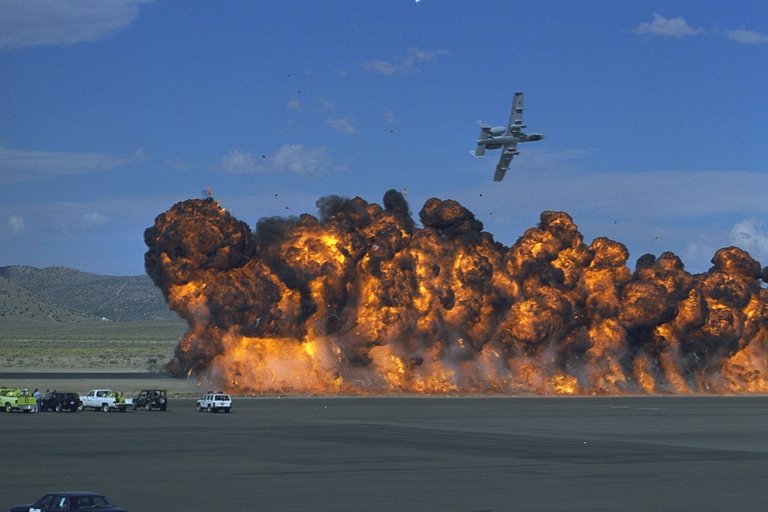
Tentative impressions are that the U.S. Air Force missed a splendid opportunity in 1991 to emulate the XIX TAC's support of Patton's right flank during WWII. A similar operation could have supported the left flanks and spearheads of the VII/XVIII Corps as they attempted to envelop the Republican Guard. We know that almost four and one half divisions of the Guard escaped in a coordinated movement with almost half of their equipment (after their retreat, some units set up blocking positions north of Basra). While the reasons for their escape are complex, several things are clear: The U.S. had complete air supremacy during the Iraqi escape maneuver, the Army and Air Force were not oriented to the enemy movement (in part, because they were focused inward to manage their own complex coordination and synchronization procedures), and CAS operations were nowhere in evidence.
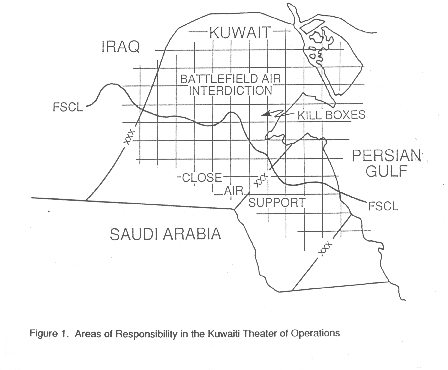
The fire and movement schemes of the A-10s were not coordinated with the fire and movement of the ground forces. Interviews with A-10 pilots indicate high levels of frustration due to over-control by central targeting authorities. According to these pilots, they were jerked around from "kill box" to "kill box" without any apparent reason. Very often it was impossible to finish the job in one "kill box" because subsequent sorties were fragged against dead targets in another "kill box". Altitude restrictions also worked to prevent the A-10s from flying low altitude column cover and armed recce in advanced of the spearheads, where the effectiveness of its GAU-8 30mm gun would have been devastating.
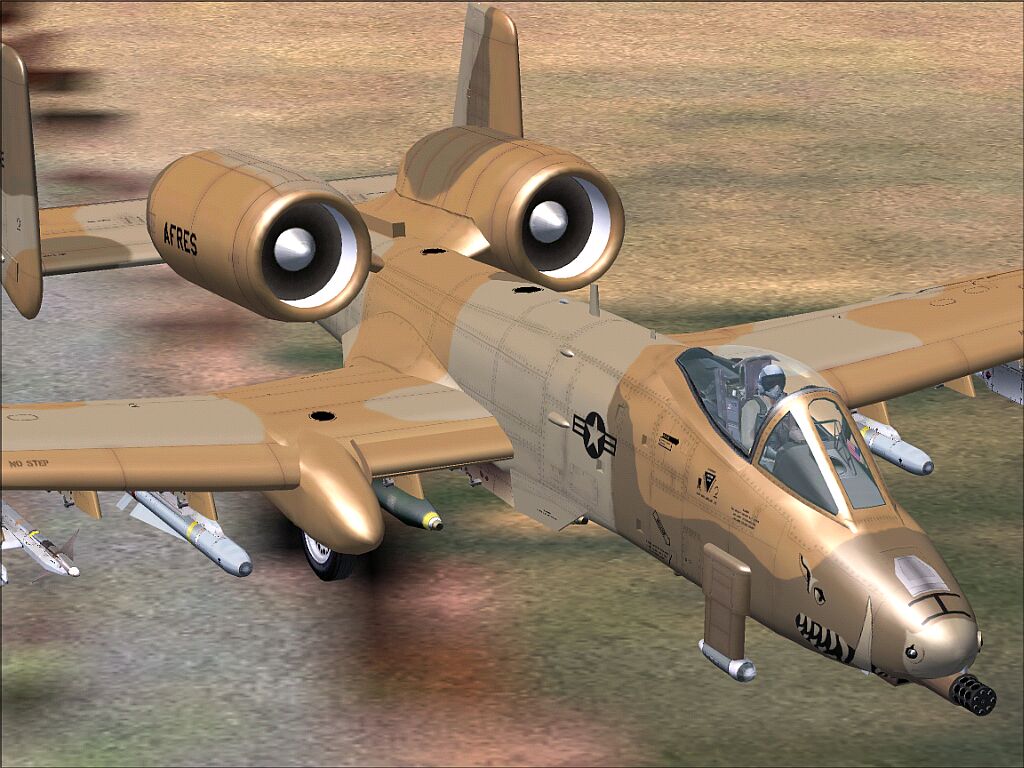
While the 8000 foot altitude floor may have decreased losses to enemy fire somewhat, it also reduced effectiveness and probably increased the probability of fratricide as well. (the A-10s attack on the Mc LAV armored cars, British Warrior vehicle is a good example of targeting problems from medium altitude with PGMs on an open low-intensity battlefield.) The importance of marking friendly positions came as surprise to many people.
Finally, we were unable to uncover any instances of AH-64/A-10 JA/AT operations in a CAS situation, notwithstanding VII Corps extensive use of JAAT doctrine in European training exercises. One A-10 pilot summed up the poor coordination when he told us that they stole the Army's invasion plan one day before the war started in order to learn about the ground scheme of maneuver.
Trade-offs among several issues relating to the effectiveness of fixed-wing aircraft in the CAS mission need to be clarified. These are:
(1) finding targets
(2) killing targets, and
(3) surviving enemy defenses.
With the exception of the Rudel interviews, which document a highly credible, albeit historically distant, personal experience; detailed combat information on these tradeoffs does not appear to be available. Moreover, there do not appear to be any recent operational tests aimed at understanding these tradeoffs. In a general sense, these tradeoffs are as follows:
Target acquisition versus survivability: Many pilots believe that slow-speed aircraft cannot survive over the modern battlefield; however, combat experience suggests that to find tactical targets (e.g., camouflaged machine gun nests, tanks, etc.), you must fly at low speeds.
Aiming time versus survivability: Once the target is found, the pilot must bring his flight path to bear on the target, aim, and launch his weapon. While he is aiming, he is flying a steady predictable flight path and is vulnerable to an air defense tracking solution. The length of time it takes to aim a weapon varies with the type of weapon; it is shortest for a gun and longest for a PGM that requires a manual lock-on such as the Maverick missile; bombs and unguided rockets fall in between.
The first question to be answered is: What are the trade-offs between speed and target acquisition? This is conceptually a straightforward test question. Target acquisition capabilities (i.e., detection probabilities and ranges) at various speeds and maneuvering profiles, and with various sensors (eyeball, IR, etc.), can be determined using state of the art instrument technologies in free-play Red-Blue operational tests -- Blue air and ground forces operating against Red ground forces. In such tests, it would be crucial that the Red team be given every freedom to defeat Blue air's acquisition.
If the test results suggest that target acquisition generally requires slow speeds, then a second question needs to be answered is:
Can aircraft survive at low speeds over a highly mobile battlefield?
This is a more difficult question to answer by testing. We need to determine if a low speed hard maneuvering airplane can find and shoot at targets while defeating the detection, tracking, or terminal guidance capabilities of air defense guns and rockets (as they would exist in a mobile air support scenario). Or if hit, could the airplane survive?
Broadcast versus close control. Today, the Department of Defense is wedded to a close control doctrine, based on a vision of wide-area surveillance systems, data links, centralized data fusion/decision-making centers, airborne FACs, precise target designation, and rapid processing of clear information through all levels of a complex C4 ISR network. The importance of marking one's own position has been de-emphasized by ground forces--a lesson painfully re-learned during the Iraq War, the use of ground FACs has been de-emphasized by aviators, and the concept of broadcast control has been totally forgotten by all parties. Consequently, today, the aviator is a passive player in the CAS game. He is not part of a combined-arms team; he simply shows up at a point in the sky at a certain time to shoot at a target he may not even see.
Yet the most successful CAS operations have occurred under very different C3 structures-usually including ground FACs operating in a broadcast control mode, marking of friendly positions, delegation of targeting authority to pilots on the scene, and most importantly, the intimate involvement of aviators (leaders as well as fighters) in the ground operation.
The free-play effectiveness tests described above should also be designed to investigate the tradeoffs among a variety of close-control and broadcast-control C3 procedures. Ultimately, these tests would require squadron-sized forces employed in fairly large ground exercises at Twenty-Nine Palms or Fort Irwin, perhaps jointly sponsored by MAWTS and Fallon, but much can be learned from a variety of small-scale free play exercises organized and run by the junior officers who will be asked to fight our wars.
A-10 as today's "Mudfighter"
Clearly the capabilities of today's A-10 "Warthog" have yet to be fully exploited by decentralized employment in close cooperation from Forward Operating Bases (FOBs) using Forward Arming and Refueling Points (FARPs) set up by Army engineers to support their ground advances like they were in WWII. The reason is that as jet fighters grew in size they needed longer and longer runways until they were no longer able to take off from a grassy field like WWII fighters were. In a sense, the same analogy is what took place with the tank--in the beginning of the war they were light and terrain agile, as the war progressed, the struggle grew more desperate and they became heavier and heavier. While this happened, the Army Air Corps then Army Air Force became a separate Air Force service branch in 1947 like the marines and both organizations began to spin off in their own self-serving directions. The Air Force pilot seeing himself above the dog-face Soldier wanted to operate from secure areas and more comfortable living areas which his early model jet aircraft needed to operate from. The marines were able to keep piston-engine F-4U Corsairs and with some USAF P-51s did operate from forward fields but their day was soon over. When Vietnam came along, post-World War II, Korean-vintage A-1 Skyraider piston-engined aircraft served admirably as CAS and escorts for USAF helicopters doing search and rescue and special operations like the Son Tay POW camp rescue mission in 1970. However, at the end of the war, the man-portable Surface-to-Air Missile (SAM) made the O-1E Bird Dog and OV-10 Bronco propeller-driven FAC aircraft non-survivable as well as all helicopters unless fitted with counter-measures. After the 1973 Yom Kippur War, where the Egyptian Army moved extremely fast SA-3 SAMs with their armored columns devastated early Israeli Air Force fighter-bombers trying to bomb/strafe them until countermeasures were determined. The survivability of manned aircraft in general in an all out war was now in question. This was when the Suppression of Enemy Air Defenses (SEAD) using combined-arms tactics like having artillery suppress the enemy's AAA weapons to free the fighter-bombers to strike were created at the technical level of war to best the SAMs and radar-guided guns. However, the Air Force faced with the same Soviet tank armies in Europe needed a plane that could fly CAS low to the ground and be faster than a prop plane but slow enough to find, identify and kill enemy tanks: that plane is the heavily armored and redundant system A-10 "Warthog".
However, the Air Force simply folded the A-10 force into their business-as-usual centralized control means and did not decentralize the A-10s so they could operate within close proximity to Army ground forces using its STOL capabilities. The key is to have the A-10s operate as "Air Cavalry" immediately upon enemy contact as shaped by mobile Air-Mech "Dragoons" and not take so long using methodical battle and air taskings coming down from centralized C4 that the only targets verified as feasible are fixed ones that are heavily defended by inter-connected air defenses. In other words, the key to operating low and relatively slow is to hit the enemy while he is off balance from the dilemma he is placed in by ground force maneuver. This is SEAD at the Brigade-level and below and using on-scene Company-level leaders using electronic devices like beacons to mark friendly forces, laser pointers/designators and pyrotechnic means; rifle grenades and their WP 105mm rounds that their M8 Ridgway light tanks can fire to mark targets. This would be backed up by moving GPS map displays in both the A-10 and on the ground in Wiesel 2s and Gavin Fighting Vehicle (G-MAV)s tracked cross-country-capable vehicles of the AMS force so that the A-10 pilot can be controlled by the Dragoons to hitting their targets using cheap non-precision guided weaponry. The A-10s would have direct communications links with the C4 Gavins and Wiesel 2s, manned by USAF TACPs or Army personnel ground FACs. This is exactly how Army Special Forces control AH-6 "Little Birds" and AH-60L "Direct Action Penetrators" armed with 30mm cannon, 7.62mm mini-guns, 2.75" Hydra-70 rockets and Hellfire missiles. The Air-Mech-Strike force would do the same with their own A-10s and OH-58D Kiowa Warriors and eventually the U/MCAS.
Imagine what would have happened October 3, 1993 had the Ranger relief column been inside Gavin/Wiesel 2 tracked AFVs instead of rubber wheeled HMMWVs/5-ton trucks racing to the scene of the 2 helicopter crash sites--they wouldn't have gotten lost, they would have brushed aside enemy fire and went where they wanted to go, and if they needed CAS it would have come from armored A-10s under direct control of the Ground force commander not vulnerable helicopters circling overhead asking to run into a volley-fired RPG.
To make this occur, 12 x A-10 Warthogs need to be assigned permanently to each of the Army's Air-Mech-Strike Corps and made to operate from the same FOBs that Army helicopters operate from. The Army already has in place the means to air-deliver bulk fuel and ammunition to keep its helicopters fueled and routinely use the USAF "fat cow" C-130 and potentially C-17s to feed their helicopters. Those C-130s and C-17s can land on short (under 3,000 foot) "Assault Zones" which is the ultimate goal of a parachute forced-entry and ParaMECH Medium Brigade delivery. These are the aircraft that will bring in the "STRIKE" part performed by Army attack helicopters. The A-10s would self-deploy alongside the Airborne Task Force acting as escorts and as soon as they are done prepping the drop zones, the Paratroopers and their Gavin Fighting Vehicle (G-MAV)s and Ridgway light tanks would heavy drop. Immediately after the Assault Zone is clear, the A-10s can land and be rearmed/refueled or wait there for follow-on missions. Air-Mech-Strike combat engineers must become expert at rapidly turning ANY piece of controlled terrain into suitable Assault Zones for the A-10 "Mudfighters", and the USAF personnel must become field-oriented, living like the "grunts" they support, rucksacks, rifles, MREs. The pay-off is that the life they will be saving by not being an easy enemy target at a huge fixed airbase will be their own.
The first Army Air-Mech-Strike Brigades to be created would employ the organic A-10 "Mudfighter CAS" concept as an Operational Maneuver Experiment (OME), and if it doesn't pan out we can always start-over or more likely it will be a smashing success like it was in WWII and it would become organic to ALL Army Corps Headquarters with Air-Mech-Strike Brigades.
Eventually USAF pilots/sustainment crews would grow accustomed to being "flying grunts" like the Army's helicopter pilots/crews are, or else the A-10s would be transferred over to the Army by Congressional mandate if these national assets are continued to be misused under centralized control from vulnerable fixed bases to pursue the Air Force let's-prove-air-strikes-alone-can-win-wars agenda, part 13 the sequel. Air Strikes only end wars if they use nuclear weapons and annihilate the enemy (Hiroshima, Nagasaki). PGMs from the air alone can only achieve a temporary effect on an enemy who has PGMs in reverse aimed effectively at the delivery aircraft and robbing them of low-level air space control which is critical to who owns the ground beneath it. If you bomb at 10,000 and up, the enemy will have freedom of action to murder, rape, pillage and burn as the bodies discovered in the mass graves of Kosovo cry out in anguish at us.
Like the A-1 Skyraider "SPADs" of the Vietnam war, the A-10s would act as the low-level air space "top cover" for the helicopters as they perform cross-FLOT operations. If enemy aircraft or air-superiority helicopters like the Ki-50 Hokum are encountered, the A-10 wards them off and destroys them so the OH-58D Kiowa Warriors can stay below the tree tops with their Mast Mounted Sights and concentrate on spotting/reporting/killing ground targets.
They will be able to attack targets in advance of moving AirMECH columns "Stuka" style but with high technology to positively identify bad guys and avoid hitting the good guys. They work directly for the Air-Mech-Strike Brigade commander.
Why V/STOL doesn't work?
In contrast to the exciting possibilities of the A-10 as a modern-day "Stuka" mudfighter, the AV-8B Harrier II is an un-survivable failure as a CAS platform. As far back as 1961 when the best-way-to-do-CAS? question was first raised, the Harrier was seen as a one-way mission aircraft to again; fight off the Soviet tank armies by being dispersed all over the NATO countryside with a nuclear weapon. It would take off with this single bomb to vaporize Red Army tank columns and probably not come back. But the point was to NOT operate from a fixed concrete runway which would be targeted and destroyed by an enemy NBC strike before or shortly after the first sortie was flown. However, the Mc ever looking to elevate its service stature bought the Harrier as a CAS aircraft not realizing it is a Deep Interdiction aircraft. "Close" in CAS means just that--CLOSE to the enemy and front lines and that means enemy small arms fire at a minimum. The Harrier with its unarmored body and fuel tanks all around its vectored thrust nozzles--infrared missile aimpoints is simply a flying death trap for the pilot. If it gets hit, it explodes. This explains the high losses the British Harrier pilots had in the Falklands war in 1982 and the Mc pilots in 1991 DESERT STORM. The main selling point for the Harrier is its V/STOL capability in order to not need runways. This is ok if you are only going to carry a single nuclear bomb, it doesn't work for chemically created explosive devices---they are too heavy and the Harrier needs a running take-off in order to carry a useful load. It may then be able to vertically land after the mission, but it needs combat engineering to mat down and firm at least a short take-off run strip and to prevent foreign objects from being ingested into its engines, which could cause a flame-out at the worst possible time, take-offs and landings. The British realize the Harrier needs a "boost" and have ski-jumps on the ends of their carriers and can be erected on land, but the Mc never bought them or had the Navy put ski jumps on the end of their amphibious ships.
www.periscope.usni.com/demo/weapons/aircraft/attack/w0003089.html
"Harrier losses during Operation Desert Storm may prove particularly worrisome because they were attributed to IR- seeking missile hits on the engine nozzles (see Operational Notes). Given the unique need to place those nozzles near the middle of the fuselage and the difficulty in masking their signature, countermeasures will be hard to devise. One probable modification is the fitting of zero-scarf exhausts to the rear nozzles, which will reduce their IR signatures by 50%. (A former Defense Department official interviewed by Aviation Week in August 1991 noted that plans to install foam in the fuel tanks and add Halon fire extinguishers were dropped in early 1989.)
Five AV-8Bs were lost during the 7-week war; 4 fell in combat, 1 was a non-combat loss. Post-war marine corps analysis revealed that the mid-fuselage location of the engine nozzles made the Harriers much more vulnerable to a fatal IR missile hit than other aircraft. For example, 4 out of 5 F/A-18 Hornets hit with heat-seeking missiles returned to base because the exhaust plume is so far aft that only the nozzles suffered damage."
Operation DESRT STORM
62 x AV-8Bs: 3,380 sorties, 4 aircraft shot down
132 x A-10s: 8,640 sorties, 6 aircraft shot down
This means twice the number of A-10s flew 3 times the number of sorties than AV-8Bs did (A-10s pulling more of the load)
And this is approximate, A-10s probably flew MORE that this.
And when you compare the loss rate of the AV-8B the A-10, the A-10 wins. The AV-8B is flying 1/3 the missions yet its losing almost the same numbers as the A-10 flying 3 times the missions.
O/A-10 20 8,640\a 0.0023
F-16 7 11,698 0.0006
F/A-18 10 4,551 0.0022
B-52 5 1,706 0.0029
GR-1 10 1,317 0.0076
=============================================================
Total 65\b 37,243 0.0017
\a Precise A-10 strike data were not available. GWAPS recorded 8,640 A-10 sorties. Given the definition of a strike, the number of A-10 strikes may have been larger than the number of bombing sorties. If the number of A-10 strikes is larger than 8,640, then its per-strike aircraft casualty rate would be lower. Of the A-10s that were hit its highly probable that bad camouflage was the culprit, not its flight characteristics.
The GAO reports:
"The fact that the optically-aimed AAA and IR SAMs remained lethal throughout the air campaign put a premium on the extent to which aircraft operating during the day could be made less visible through camouflage. A-10 pilots told us that the aircraft's dark green paint scheme--intended for low-level operations in northern Europe (including for concealment from aircraft from above)--made them stand out in the desert against both sand and sky. Consequently, some A-10 units began to paint their aircraft the same light gray color scheme of most other Air Force aircraft. However, the units that repainted their A-10s were subsequently ordered by Air Force Component, Central Command (CENTAF) to change them back to dark green.A total of 20 x A-10s was hit during the war--nearly 25 percent of all aircraft casualties. Some A-10 pilots we spoke to believed--and one participating unit's after-action report stated--that the dark green paint was unacceptable and may have been responsible for some of the casualties. A post-war Air Force study on survivability stated that the concerns over the A-10's paint scheme were "valid" and recommended that, in the future, "Paint schemes must be adaptive to the environment in which the aircraft operate."\46 It is noteworthy that no A-10s were shot down, or even damaged, at night, when the dark paint scheme very probably assisted them or, at minimum, did not make them stand out."
AND!!!!!!!!!!!!!
The Mother #$%^&* Navy/Mc will not put a ski jump on their LHA/LHDs so the pilot can have a fighting chance to eject in a flame out or improve efficiency because the mother #$%%^&* Mc is a BS outfit not interested in warfighting, only service bashing posturing!
http://www.periscope.usni.com/demo/weapons/aircraft/attack/w0003089.html
"Results of the December 1988 ski-jump trials of the EAV-8B aboard the Spanish sea-control ship PRINCIPE DE ASTURIAS were better than expected. Using the 12-deg ski jump, aircraft at the maximum gross weight of 31,000 lb. (14,061 kg) required only a 400-ft (122-m) deck roll. In a November 1989 article in marine corps Gazette, the former AV-8B program manager noted that if large landing ships such as the TARAWA- (LHA 1) and WASP- (LHD 1) classes used a portable ski-jump, they could operate AV-8Bs from the forward half of the flight deck and rotary- wing or tilt-rotor aircraft on the after half at the same time."
Thus, the Harrier is a STOL, perhaps STOVL aircraft that needs a semi-prepared runway, and if you have to invest in that anyway, why not get a battle-hardened A-10 and twice the bomb-load and 3 times the SAFETY? You will not be killing your pilots in "accidents" in A-10s like you would in the AV-8B. The new Joint Strike Fighter will have STOVL capabilities but will not be survivable against enemy small arms fire; it will simply be a F-16 that can fly point bombing missions above the enemy Air Defense envelope ala Kosovo and land like a Harrier II. It will not be able to do CAS.
Let's say you could make an armored A-10 type aircraft STOVL capable. The fuel costs of operating that way would increase to that of a helicopter, to fly vertical costs you in fuel. And for a power-projection force you need aircraft that sip, not guzzle fuel. Thus, the A-10's ultimate replacement will be a "killer" Unmanned/Manned Aerial Vehicle (UAV) which could be a pilot-less A-10 replacement if it becomes "too dangerous" for pilots to fly missions inside it. This makes a heck of a lot more sense than turning them into remotely piloted drones so someone can have the thrill of shooting them down at a test range.
The A-10 "Thunderbolt II" (Its official nickname) operating like its P-47 Thunderbolt ancestor would be away from predictable air bases, moving under the protective umbrella of the Army from FARP site to FARP site, and avoid being targeted for destruction by enemy attacks.
www.fas.org/man/dod-101/sys/ac/a-10.htm
Why not have the 88 x ANG/AFR A-10s and 42 x OA-10s align themselves to the Army's V Corps that do not have them for a CAS habitual relationship? XVIII ABN Corps has Active AF A-10s at Pope AFB for CAS.
This way the Active AF will still have ego-gratifying A-10 control for MTWs, and the RC A-10s a mission to do and an ability to act as a "training aid" for the warfighting Army Corps HQs and AMS BCTs to perfect EXCELLENT Close Air Support not ad hocery.
A-10 OA-10
Active force 72 72
Reserve 24 12
ANG 64 30
The GAO reports: www.fas.org/man/gao/nsiad97134/app_04.htm
For example, the fleet of 42 x F-117s deployed to Desert Storm cost $4.7 billion to develop and build, while the three times larger fleet of 148 A-10s cost $1.7 billion; that is, 106 additional aircraft for $3 billion less. Similarly, for the same amount of money, very different sized fleets, and capability, can be procured. For example, $1 billion in funding would procure 9 x F-117s or 85 x A-10s. The Desert Storm performance data reveal that the 9 x F-117s would have carried out fewer than 7 sorties per day; in contrast, the 85 x A-10s would have flown 119. While the design missions of the two aircraft differ substantially, their use in Desert Storm demonstrated that they are not necessarily mutually exclusive.
Based on its performance in Desert Storm, advocates of the F-117 can argue that it alone combined the advantages of stealth and LGBs, penetrated the most concentrated enemy defenses at will, permitted confidence in achieving desired bombing results, and had perfect survivability. Advocates of the A-10 can argue that it, unlike the F-117, operated both day or night; attacked both fixed and mobile targets employing both guided and unguided bombs; and like the F-117, it suffered no casualties when operating at night and at medium altitude. In short, the argument can be made that to buy more capability, in the quantitative sense, the most efficient decision could be to buy less costly aircraft. Moreover, to buy more capability in the qualitative sense, it may be a question of what specific capability, or mix of capabilities, one wants to buy: in the F-117 versus A-10 comparison, each aircraft has both strengths and limitations; each aircraft can do things the other cannot. Therefore, despite a sharp contrast in program unit costs, based on their use, performance, and effectiveness demonstrated in Desert Storm, we find it inappropriate to call one more generally "capable" than the other.
In terms of unit cost, the single-role aircraft are both the most and the least expensive (the B-52 and the F-117 versus the A-10).\7 In terms of the average daily sorties, only the single-role A-10 exceeded the multi-role F-16's and F/A-18's rate of 1.2 per day. Excluding the B-52, multi-role aircraft had the highest as well as the lowest average daily munition tonnage; the F-15E was the highest, at 2.71 tons, and the F/A-18 was the lowest, at 0.74 tons.
LOW-COST U.S. ARMY U/MCAV "MUDFIGHTER"
Make the Rutan ARES a dual-option Unmanned or Manned Combat Air Vehicle (U/MCAV) platform--perhaps flown by U.S. Army 96U enlistedmen or re-certified AH-1/UH-1 Aviators who are now without a platform to fly--with Enlisted Airborne Forward Air Controllers (AFACs) as Observers.


 www.youtube.com/watch?v=zG9LlHcX8lg
www.youtube.com/watch?v=zG9LlHcX8lg
Wood Model (desktop)
http://cgi.ebay.com/Rutan-Model-151-Ares-Mudfighter-Wood-Model_W0QQitemZ220340461435QQcmdZViewItemQQptZLH_DefaultDomain_0?_trksid=p3286.m20.l1116
http://myworld.ebay.com/fighterfactory/
Flying R/C Model (huge)
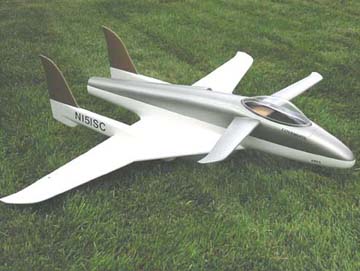
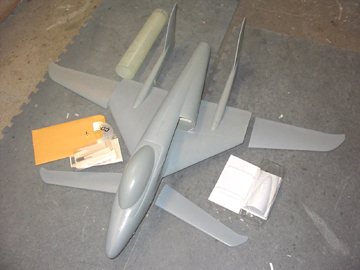
K&A Models Unlimited
P.O. Box 66527
Albuquerque, NM 87193-6527
info@kamodels.com
(505)994-8083
FAX -8138
Agile Responsive Effective Support
The ARES, Scaled Model 151, was designed initially in response to a U.S. Army request for a Low Cost Battlefield Attack Aircraft (LCBAA). A design study was performed by Rutan Aircraft Factory in 1981 for such an aircraft. The original LCBAA design was for a pusher turboprop aircraft, of generally the same aerodynamic configuration you see here. It also was designed around a 30mm chain gun. Its mission goals were low-altitude, close air support, with long endurance, and with adequate field performance to operate from roads. Its structure and systems were simple enough to be maintained and repaired in the field.
Scaled followed up with the concept, and ultimately decided to build a demonstrator aircraft with internal funds (THAT'S PATRIOTISM). By the time construction started in 1986, the design had evolved to the current configuration: a single Pratt and Whitney Canada JT15D-5 turbofan engine (same as in the Beechjet/T-1A Jayhawk), and a GAU-12/U 25mm gatling gun.
The ARES first flew on February 19, 1990, with Scaled test pilot Doug Shane at the controls. Since that first flight, the ARES has flown more than 180 hours, and demonstrated all of its design performance and handling qualities goals, including departure-free handling at full aft stick. During November of 1991, under a contract from the U.S. Air Force, initial ground and flight (air-air and air-ground) tests of the GAU-12/U gun system installed in ARES were performed, with outstanding results.
Movie buffs may also remember the ARES villainously portraying the secret ME-263 jet in the screen classic Aces: Iron Eagle III.
The ARES is currently in flyable storage at Scaled Composites' Mojave facility.
Scaled Composites Facility. Scaled is located at 1624 Flight Line, Mojave, CA 93501-1663. You may reach them by phone at (805) 824-4541, by fax at (805) 824-4174, or by email to info@scaled.com
The following is an overview of the Scaled Composites ARES demonstrator aircraft. Discussed are program origins, design considerations and features, and results of testing, including the effects of live firings with a 25mm cannon on both handling qualities and the composite structure. Its asymmetric fuselage configuration shows promising results in the ability to tailor handling qualities to minimize dispersion during gun firing, and in the ability to protect the engine inlet from gun gas and ground FOD ingestion. Loads encountered from both gun recoil (average 7000 lb) and blast pressure (with peaks over 100 psi) are well below the structure's allowable limits. The ARES is a single-engine, single-seat concept demonstrator for a multi-mission aircraft capable of anti-helicopter, light anti-armor, border patrol, tactics training, and other missions. It is canard-configured, has a wingspan of 35 ft, an empty weight of approximately 3600 lb, and is powered by a Pratt and Whitney of Canada JT1 5D-5 turbofan engine.
Background

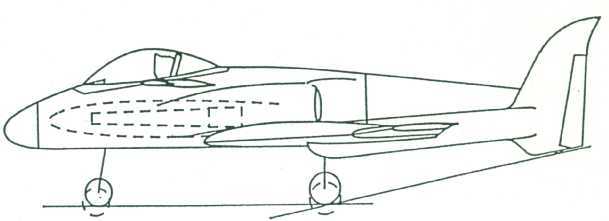
ARES began life as an idea in the minds of U.S. Army Aviators Jim Kreutz and Milo Burroughs at Ft. Lewis, Washington. They firmly believed that something was needed to meet the increasing threat of Soviet air-air helicopter capabilities and the absence of adequate Close Air Support (CAS) aircraft (and doctrine) in the U.S. inventory (Reference 1). They took advantage of a new command called the 9th Infantry Division High Technology Test Bed (HTTB), whose charter was to look for new ways to streamline the Army's procurement processes, to propose that what the Army really needed was not just a better attack helicopter, but rather a fixed-wing aircraft optimized to fly and fight in the helicopter low-altitude environment. This is the same conclusion the Army originally made in the early 1960s with its armed OV-1 Mohawk program that got shelved by selfish USAF /DOD politics that wanted only the USAF to fly fixed-wing aircraft when the Army should be able to fly whatever type aircraft works best. The low-level battlespace in close proximity to Army ground maneuver forces should be under the jurisdiction of the Army and everywhere else where the Army is not, the USAF. A significant advantage of the fixed-wing airplane was its speed, range and time-on-station capabilities, both well in excess of helicopters due to the greater fuel efficiency of fixed-wing flight. One of their important goals, resistance to departure from controlled flight (especially important at low altitudes), led them to the door of Burt Rutan (American hero/genius), then the principal of Rutan Aircraft Factory, and currently president of Scaled Composites, Inc.
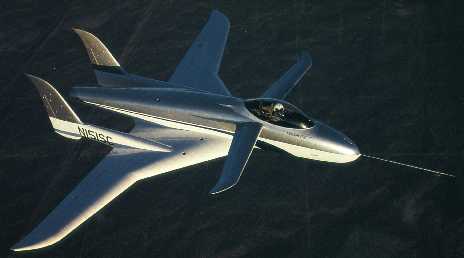
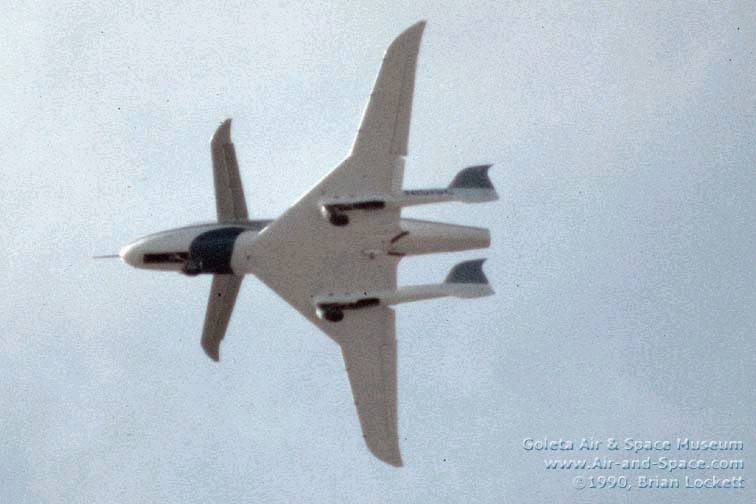
Two important developments came as a result of their meetings in Mojave. First, they were able to generate sufficient interest at general officer levels to perform a two-phased program. The first phase included the preliminary sizing and design of a Low-Cost Battlefield Attack Aircraft (LCBAA). This was performed during 1981 and 1982 by Rutan Aircraft Factory. LCBM used Army-inventory hardware as much as possible, including the Allison turboshaft engine used in the OH-58, and avionics and weapons systems. A turboprop pusher canard configuration, the LCBAA promised high agility, maneuverability, and departure resistance, combined with a 200 kt cruise speed and 4 hour duration. The second phase allowed building two Long EZ homebuilt aircraft for use as tactics demonstrators, as well as to evaluate detectability and composite reliability and maintenance characteristics.
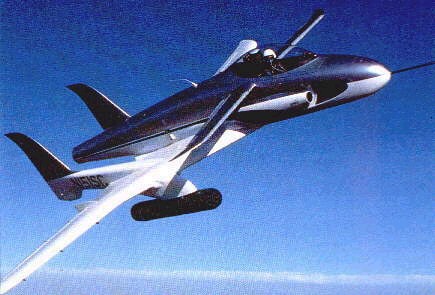
Of course, this whole notion of a low-cost, fixed-wing, CAS aircraft for the U.S. Army flew in the face of several deeply-entrenched narrow-minded, defeatist USAF/DOD policies, which ultimately resulted in the second important development of LCBM: both Kreutz and Burroughs had to find other lines of work, because their U.S. Army careers were over, as often heroes and visionaries find themselves when fighting corrupt bureaucracies full of selfish, narrow-minded egotistical people more concerned with their own "rice bowl" than the greater common good---in an attempt to save the day before we have a national geostrategic disaster. The LCBM concept, through no technical fault of its own, (and possibly because of the successes of the two Long EZ demonstrators in operational evaluations) was simply too controversial for those in love with the status quo that gave us such disasters as Vietnam, Koh Tang island and Lebanon.
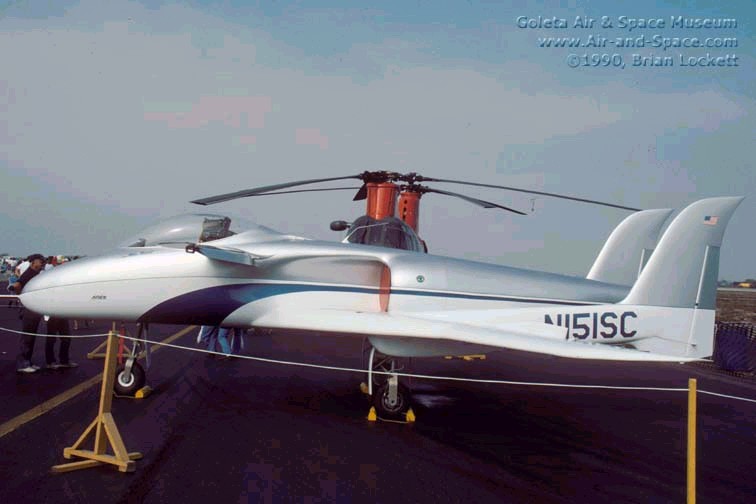
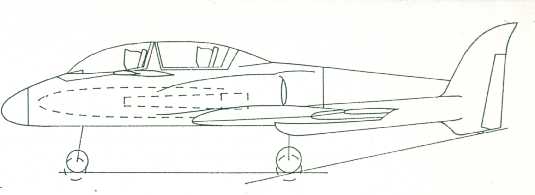
Still intrigued by the concept, Burt Rutan (a true American hero) kept the idea alive, at least within Scaled Composites and its parent company from 1985-1988, Beech Aircraft. When Burt was able to get verbal assurance from highly-placed Pentagon officials that "if you'll build it, we'll evaluate it", Tom Phillips (Another hero), then president of Raytheon, approved the allocation of a small amount of research funding to develop the design and build a demonstrator.
As the design progressed, a couple of important design features evolved. First, while there had been considerable thought given to designing the aircraft around a 30-mm cannon, the perceived political sensitivities to a potential A-10 threat dictated using a 25-mm gatling gun, the General Electric GAU-12/U. This would still allow evaluation of the "big gun, small composite airplane" suitability, it would enable the destruction of most target types up through light armor, and would be much more likely to get evaluated by the U.S. military.
The other important evolution was from turboprop to fan-jet propulsion. Scaled's (and others') experience with pusher propellers showed two major faults for this type aircraft. The pusher propeller is highly susceptible to damage from surface debris kicked up from the nose wheel, and this aircraft was designed to operate from soft or rough unimproved fields or those littered with battle damage. Also, the pusher propeller lives in the air flow wake of the body in front, and particularly in a highly maneuverable airplane, this can result in high propeller loads as it sees the changing and sometimes separated flow field coming off the body and flying surfaces ahead. This has not only structural implications, but also reduces propeller efficiency.
The new airplane, designated Model 151, got a new acronym. Instead of LCBAA, it became Light Attack Turbofan Single, or LATS. Construction began in 1987, and when Beech Aircraft sold Scaled in 1988, Scaled bought the program back and finished it out of company funds.
The final acronym, and the one used now, is ARES. Although ARES is the Greek god of war, it also stands for Agile Responsive Effective Support.
Design and Fabrication Details
The ARES has a number of unique features about its design, which are described in the following paragraphs.
-ARES General Dimensions
Overall length: 28.6 ft
Wing Span: 35.O ft
Wing Reference Area: 191 sq.ft
Empty Weight: 3600 lbs
Gross Weight: 6700 lbs
Fuel Capacity: 2200 lbs
Engine: JT1 SD-S
Thrust Rating: 2900 lbs
Armament: 25mm Gatling autocannon GAU-12/U, 220 rounds
2 x AIM-9 or 4 Stinger AAMs, 2 x 2.75" Hydra-70 rocket pods
Aerodynamics
A loaded-canard aerodynamic configuration was selected to allow development of unaugmented departure-free handling qualities. This is a key feature of the design, and one which helps allow the pilot to operate the airplane more safely in terrain flight.
In order to provide these departure-free qualities, the configuration must be designed so that the canard surface reaches its critical angle-of-attack first. Then, because of both the nose-down pitching moment and because the elevator (pitch) control separates also, airplane angle of attack cannot be further increased, and the wing is protected from stall. This allows a relatively "soft" degradation in pitch handling qualities at minimum speed, while allowing full roll and directional control. This allows the pilot to use all of his available lift at any time, by applying full aft stick, without worry of loss of control.
The canard on ARES has a span of 19.2 feet and an area of 35 sq. ft. It is swept forward 7 degrees at the leading edge to allow it to be mounted aft of the pilot. It is fitted with slotted flaps that function as elevators, which are directly connected to the control stick via pushrods.
The main wing has a span of 35 feet and a reference area of 191 sq. ft., not including the strakes. It is swept aft 16 degrees at the leading edge. The strakes, which may be thought of as external conformal fuel tanks (as compared to magical vortex lift aids), are swept 49 degrees at the leading edge. These strakes, combined with a wet wing center-section area, form the bulk of the 2200 lbs. (approximately 333 U.S. gallons) fuel capacity. The wing has conventional ailerons on the outboard trailing edge, and "spoil-flaps" (similar to the dive-brake flap in Reference 2) on the inboard trailing edges. The ailerons are actuated by push-rods, and the spoil-flaps are hydraulically operated.
Directional stability is provided by twin boom-mounted fins, each of 18 sq.ft. area. Each has a cable-actuated rudder at its trailing edge. The rudder actuation system also drives the full-time mechanical nosegear steering for ground operations. also used on the Scaled Triumph business jet, which was tested between 1988 and 1990.
To help get the gun recoil reaction closer to the aircraft lateral center of gravity (CG) location, the gun is submerged as deeply as practical into the right side of the fuselage. Also, the fuselage is not centered about the aircraft centerline, but is offset to the left by three inches. This results in the firing barrel of the gun being only about 18 inches from the lateral CG.
Structure
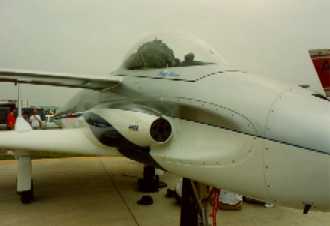
The engine inlet is another major unique feature of ARES. Since gun gas ingestion posed significant problems in other aircraft development programs (A-10, as one example), the configuration of ARES was designed to avoid this problem: the engine inlet is entirely contained on the left side of the aircraft, and the gun is installed on the right. The inlet (Figure 2) has a circular cross section, and is straight into the fan face. As a result, the engine is mounted slightly transversely in the fuselage, with an 8-degree misalignment from butt line. The inlet is effectively submerged into the fuselage, and in fact the outboard inlet highlight can barely be seen from the nose of the airplane. The inboard highlight has a boundary layer bleed area, which is used for engine compartment scrub cooling. Although there was some concern about inlet distortion and vortex ingestion prior to flight test, it appears as though the canard, wing strake, and fuselage side act as flow straighteners which limit the effects of airplane angle of attack and side-slip on inlet distortion. Inlet distortion tests have shown this configuration to have lower average distortion than commonly-used bifurcated duct designs.
The engine exhaust is turned back to butt-line by a curved composite tailpipe. A composite tailpipe was To help get the gun recoil reaction closer to the aircraft lateral center of gravity (CG) location, the gun is sub-merged as deeply as practical into the right side of the fuselage. Also, the fuselage is not centered about the aircraft centerline, but is offset to the left by three inches. This results in the firing barrel of the gun being only about 18 inches from the lateral CG.
The ARES airframe structure is effectively all composite. The fuselage is almost entirely fiberglass/epoxy (gil ep) laid up over PVC foam cores. In the local area of the gun installation, there is also a significant amount of aramid material interleaved with the fiberglass to resist blast pressures. The entire gun depression area is integral with the right hand fuselage half, with no secondary bonds, ribs, frames or stringers. This is typical of the entire airplane; in fact, the whole fuselage has only three bulkheads.
On this demonstrator aircraft, significant use of "moldless" composite fabrication techniques was made. This method, ideal for a one-off prototype, involves shaping foam cores and then applying skins to form a composite sandwich or, in the case of flying surfaces, using full foam cores, usually shaped with a hot wire saw, over which are applied the laminate skins. In the case of the ARES, the flying surfaces, including much of the wing, all of the canard, elevators, ailerons, vertical fins, and rudders are full polystyrene foam cores with either gliep or graphite/epoxy (grlep) facings. Grlep is only used where stiffness dictates.
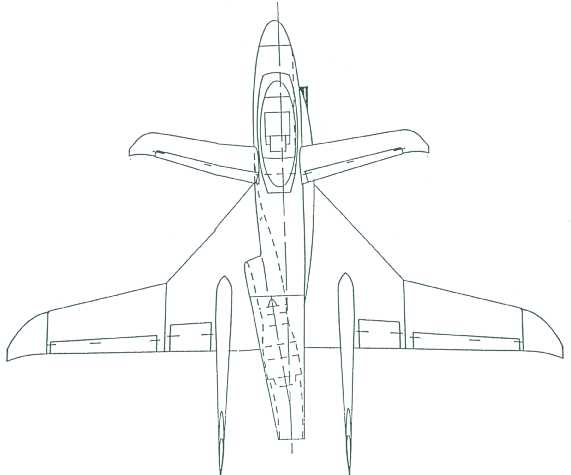
Figure 2: The ARES engine is mounted 8 degrees off centerline, uses a straight inlet, and a curved tailpipe.
These fabrication methods were used on the ARES because of Scaled's excellent historical results with similar structures in applications from homebuilt aircraft (of which more than 2000 are flying all over the world) to remote piloted vehicles (including the Teledyne Ryan Aeronautical Scarab and the Israeli Aircraft Industries Searcher) to space launch vehicle structures (the Orbital Sciences Pegasus) to racing yachts (the America's Cup defender catamaran) and several other demonstrator aircraft.
The wing is one-piece, with continuous full-span carbon fiber roving spar caps, and is permanently bonded to the fuselage. In the demonstrator, no facility is made for ground transporting; this may not be the case with a production version. The strake areas, as well as the wing volume underneath the fuselage and back to the main spar, is hollow for fuel storage. The fuel tankage is integral, without bladders or other special sealants of the 2200 lbs. (approximately 333 U.S. gallons) fuel capacity. The wing has conventional ailerons on the outboard trailing edge, and 11spoilflaps" (similar to the dive-brake flap in Reference 2) on the inboard trailing edges. The ailerons are actuated by push-rods, and the spoil-flaps are hydraulically operated.
Redundant directional stability is provided by twin boom-mounted fins, each of 18 sq.ft. area. Each has a cable-actuated rudder at its trailing edge. The rudder actuation system also drives the full-time mechanical nose-gear steering for ground operations. also used on the Scaled Triumph business jet, which was tested between 1988 and 1990.
ARES, in keeping with its goals of low-cost and high reliability, has primarily off-the-shelf general aviation aircraft systems. The engine, the Pratt and Whitney Canada JT1 SD-S, is used in the Beechjet and in the USAF's new T-1A Jayhawk multi-engine trainer aircraft. The hydraulic system, used for speedbrakes and landing gear actuation, uses a Piper Malibu hydraulic pump, which operates at 1500 psi. Instrumentation for the demonstrator consists mainly of standard general aviation equipment.
The fuel system consists of the aforementioned wing tanks, which are separated into three compartments internally, and an all-attitude header tank in the fuselage which can gravity-feed the engine. Fuel from the wing tanks is pumped through four jet ejector pumps to the header tank, which is normally kept full and can overflow back to the wing as it overfills. This header tank, which would be armored in an operational airplane, holds 150 lbs. of fuel, enough for about 15 minutes of flying at low cruise power.
The demonstrator is equipped with a Universal Propulsion Company/Stencel model SIIIS-3ER ejection seat. This seat, normally used in U.S. Navy versions of the A-7, has zero/zero capability, and is usable to approximately 600 KCAS. It ejects the pilot directly through the closed acrylic canopy. This seat was used as a matter of convenience; its high-speed envelope capabilities exceed the needs of the ARES.
The JT1 SD-S engine in the ARES produces 2900 lbs. of thrust at sea level. It has an electronic fuel control unit that provides control of engine acceleration, deceleration, and speed and temperature limiting. The result is a "full throttle" engine that can be operated as aggressively as needed by the pilot.
Mission-related systems in the ARES currently consist of a GEC Avionics Head-Up Display (HUD), a General Electric GAU-12/U 25mm Gatling gun, and a right-wing inboard pylon configured with a standard 14-inch ejector rack, for carriage of other ordnance.
The HUD is currently configured only for the standby sighting reticle, which was used during the gun testing program, but is compatible with all F-16 type symbology and displays.
The gun has 5 barrels, is capable of firing approximately 4000 rounds per minute, and has a muzzle velocity of about 3400 ft/sec. It is also used in the Mc AV-8B Harrier II aircraft, as well as the AC-130U and Mc Air Defense version wheeled armored car "Light Armored Vehicle" and the same 25mm ammunition used in the U.S. Army's Bradley Fighting Vehicles and foreign Army M113 Gavin AIFV variants. In the ARES, it is configured to fire 1800 rounds per minute, and carry 220 total rounds, although the prototype feed system was limited to 40 rounds. In the ARES installation, it is driven by a nitrogen-fed pneumatic system.
ARES has completely mechanical, reversible flight controls, to keep both fabrication and operating costs low. Although developing good control forces through-out its operating envelope has been challenging, the result is a simple, very low maintenance system, ideally suited for austere operating environments. Since the engine has a hydro-mechanical fuel control in addition to the electronic unit, the airplane is safely flyable in the event of a total electrical system failure.
Flight Test Results
Prior to the start of testing, two likely risk areas were identified for the early flights. These were 1) the effects of the inlet/fuselage asymmetry on directional trim and 2) the operating characteristics of the inlet/engine sys-tem under conditions of sideslip or elevated angle-of-attack. As a result, during runway flights and the early part of the first up-and-away flight, the assessment of rudder position and sideslip angles became as much of interest as the elevator position and angle of attack, and only moderate power was used until the envelope was cleared at altitude.
The ARES flew for the first time on 19 February 1990. In fact, the airplane made two flights that day: the first, made by the author, consisted of basic stability, control, and engine operating checks, and was made gear-down. The second, made by Mr. Michael Melvill of Scaled, included gear retraction, significant envelope expansion, and aerobatics evaluations.
Fortunately, the asymmetry effects were not large (although present), and the engine performed perfectly, with no adverse response to sideslip, angle-of-attack, or engine power settings. Over the next few flights the angular limits were expanded to include full aft stick (a maximum steady 13 degrees, with overshoots to about 17 degrees) and full rudder deflection each direction (a maximum of about 19 degrees sideslip), at all combinations of power from idle to full throttle.
As ARES is a company-funded effort, data acquisition requirements have been met in the simplest way possible. As a result, steady-state data are read from panel meters and gauges. Forces are measured with a hand-held force gauge. When dynamic information is needed, an 8-mm video camera is used, mounted over the pilot's shoulder, to record the instrument panel or the horizon to observe dynamic motions. Obviously, this has limited the ability to precisely document many of ARES' characteristics, but in most cases the limited static stability and performance data and qualitative evaluations have been adequate for our requirements.
Stability and Control
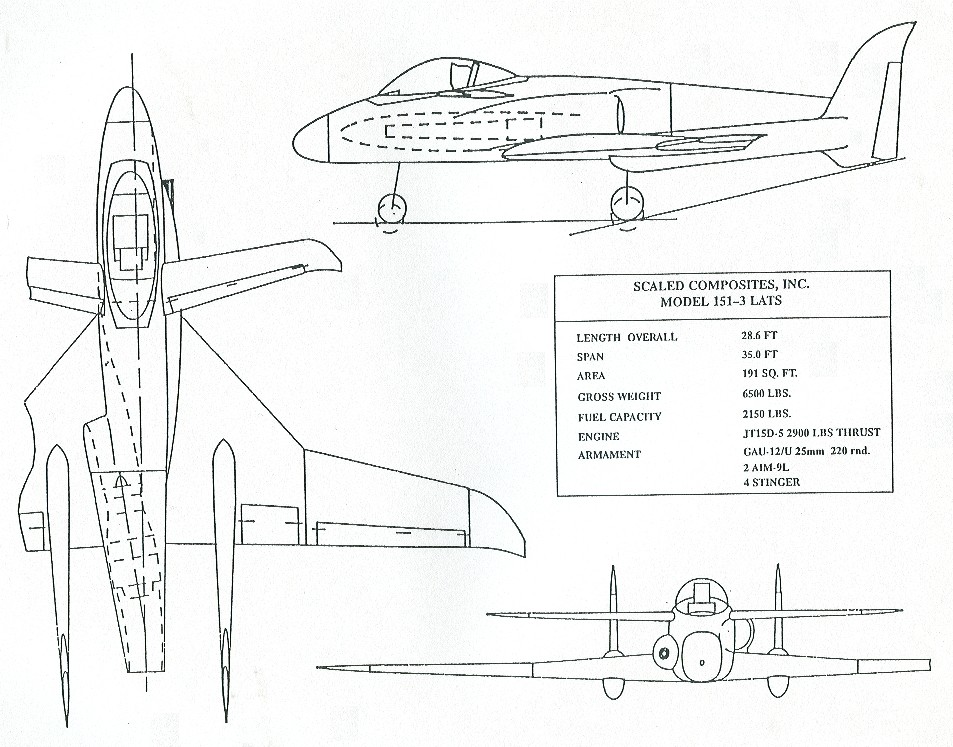
Basic static and dynamic stability of the ARES has proven to be good. Figures 3 and 4 present the static longitudinal stability characteristics at two CG locations. Of interest is the stable break in both elevator position and stick force at higher angles of attack1 proof that the separation is happening on the canard1 as designed. Full aft stick can only generate about 11 degrees angle of attack in a stabilized condition.
Static directional stability is positive, although the asymmetry effects are seen in the rudder-sideslip plot of Figure 5. Some refinement of these characteristics1 which change with power as shown in Figure 6, has been made by reshaping the tailcone area to result in a more concentric tailpipe tailcone area. Also, some enhancement of directional stability has been recommended to enhance gun-tracking precision.
Control forces have required several modification iterations. The first priority was roll forces; the original aileron balance ratio of cc .38 was insufficient, and forces were far too high. Some ground adjustment of this balance ratio had been designed into the hinge brackets, but not enough, so the ailerons have ultimately ended up with a ccf of .46 plus an average .7-inch trailing edge trim, which results in acceptable aileron forces to perform full deflection rolls at the maneuvering speed.
Refinement of maneuvering pitch forces required new elevators. The original versions required about 13 lbs. The new elevators, with a significantly revised hinge point (external vs. internal), require only about 5 lbs, as seen in Figure 7).
Stall characteristics have been as-predicted with strong natural angle of attack limiting, and full roll and yaw authority even at full aft stick. Although a rigorous departure/spin susceptibility program has not been performed yet, all indications are that its behavior will be benign. During maneuvering, full aft stick at speeds up to 210 KIAS has been used, with the only result being a startling turn rate (described below in the performance section). The aircraft is currently g-limited to +6, and was designed to a limit load factor of +8 g.
Performance
The most impressive aspect of ARES' performance, from the pilot's viewpoint, is its turning performance. Due to its low wing loading (about 34 lb/sq. ft at maximum weight) and low stall speed (78 kt) and a corner (maneuvering) speed of 210 kt, maximum turn rates of 32 degrees at 6 g, and 36 deg/sec at 7 g are possible, as shown in Figure 8.
With its large internal fuel volume and good cruise efficiency, ARES is capable of long range (in excess of 1200 nm at 25,000 ft) and long endurance (5 hr at a radius of action of 100 nm).
Climb rate and specific excess power performance are depicted in Figures 9 and 10. These data were gathered during level accelerations, using videotape re-cording of the airspeed indicator and altimeter for data acquisition.
Takeoff distances average about 1200-1500 ft, with liftoff coming at about 90-95 kt. Normal approach speed is 95-100 kt, with touchdowns at 80-85 kt. With a relatively large amount of idle thrust (200 lb), and no specific excess power of the ARES at 6500 lb. lift dumping or anti-skid Systems, landing distances have been longer, at 2000-2500 ft at medium weights and using moderate braking, although at very light weights, during the filming of ACES: Iron Eagle Ill, the airplane was successfully operated from a 1200 ft runway. One proposed modification is a thrust attenuator system, to reduce effective idle thrust and allow faster ground deceleration for normal operations.
Gun Testing
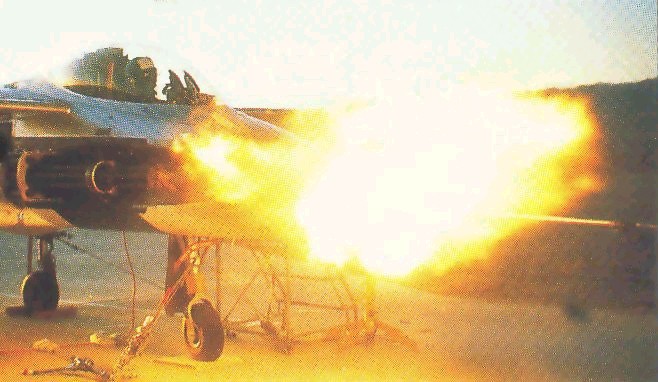
A visit to Scaled by the USAF Chief of Staff in the fall of 1990 resulted in a small contract from the Air Force, through ASD/XR, the Wright Labs, and Science Applications International (the prime contractor) to evaluate the ARES, the largest part of which included the initial testing of the 25mm cannon system.
The tests took place between 15 and 25 November 1991 at the Mojave Airport (ground firings), the Baker range at NWC China Lake, CA (air and air-ground initial firings), and at the Viper range (air-ground), owned by Flight Research, Inc., 9 nm east of the Mojave Airport in the R-2515 complex airspace. Some 235 rounds were fired during the 15 ground firings, and 445 rounds in flight, over 18 sorties.
Goals for the ground tests included verification of proper gun system operation, including function, rate, and dispersion, as measured at a target 1000 inches from the muzzle. Structural loads were measured at 12 locations of interest in the region of the gun, including the muzzle blast area and mounting points. Maximum strains in the composite structure were 3000 microstrain, only about 1/3 of allowable maximums. Data were sampled at several rates up to 2000/second, using an Elexor LB-386 laptop personal computer and Optimal software. A sample of the strain data is shown in Figure 11.
During one of the early ground firings, one round of ammunition failed due to a case separation of the shell, which left part of the shell in a barrel, causing the next round inserted tojam and lock the gun. Thanks to some spectacular efforts by the General Electric representative and the Scaled ARES crew, the gun was dis-mantled, several bent parts changed, and reinstalled within 3 days, including the shipping of new parts from GE's Burlington, Vermont plant.
However, the fact that one round had failed required that another lot of ammunition be procured to continue testing. The normal 3+ week procurement cycle would not work, as funding only existed to keep GE and SAIC personnel on station for a two-week period. After several dozen phone calls, some very gracious accommodations were made by Navy personnel, and with what amounted to an bun from the Air Force, we obtained 640 new rounds of 2Smm ammunition in just 3days.
The first flight firing was made at the Baker range at China Lake, with a 5-round burst fired in level flight at 10000 ft. For the first three flight firings, the chase plane was a homebuilt Long Ez aircraft, so the firing speeds were lower than desired at 140-150 KIAS. Airplane reactions were consistent to gun firing, with some yaw to the right (favoring the recoil reaction) and, to a lesser extent, nose-down pitching (the cause of which is not clear).
The next four flights, also made in the China Lake range, were chased by a Lockheed T-33, which allowed firing at a more normal 200-220 kt. These included three air-ground deliveries, at slant ranges from 10000 to 2000 ft. During the fourth sortie, the gun was fired at about 10 degrees angle of attack (4 g at 180 kt) to assess engine operati9n and the possibility of gun gas ingestion. No adverse operational effects were noted, and later analysis of ground-air video showed that the gun gas remained on the right side of the airplane, well away from the inlet. The remaining sorties were made at the Viper range, and were all air-ground. The firings were mostly 20 rounds, and at slant ranges from 2500-1500 ft at 210 kts. Similar aircraft reactions were noted, and ground pat-terns indicated a consistent down/right delivery of bullets. Significant boresight mismatch (about 10 mils at 2 o'clock was the aimpoint compared to the pipper center) and pilot proficiency (neither of the two pilots
1.5 had previous air gunnery experience) kept the 20 x 40 ft target banner out of danger, but not by much (one inch was the closest hit to the banner). A sample of air-ground dispersion for a 20-round burst is shown in Figure 12.
Figure 12: Sample ARES Air-ground dispersion data shows down-and-right firing tendency.
In the opinions of both the GE representative and Scaled engineers, the yawing/pitching tendencies can be overcome with development of a blast diffuser diverter. It is felt that the goal of low-dispersion 25mm gunnery with un-augmented, manual flight controls can be realized with moderate refinements.
Significantly, all gun testing was performed within the 2-week period, despite several glitches with ammunition and range coordination. In fact, on the last day of testing, the airplane made 10 air-ground sorties without maintenance or refueling.
Other Tests
Under contract to the U.S. Navy, Scaled developed an all-composite 19-tube 2.75 inch rocket launcher. This proof-of-concept launcher, as well as a baseline LAU-61, were flown on ARES in the summer of 1991. The purpose of these flights was to compare drag of the various launcher configurations. As a result, Scaled developed an instrumented pylon to carry a standard 1 inch ejector rack, which measures store drag through an internal load cell. The tests went well, and future goals include live firings of 2.75 inch rockets from the ARES, as well as other stores testing.
ARES participated in a series of infrared/electro-optical tests sponsored by the Naval Weapons Center called Long Jump in 1990. The results of these tests remain to be published as of the writing of this paper. Also, significant radar cross section testing has been per-formed on ARES. While no attempt was made during either the design or fabrication of the demonstrator to incorporate signature-reduction technologies (to help ensure exportability), it is felt that with the treatment of some obvious areas the ARES could have respectably low RCS and IR signatures.
Conclusions
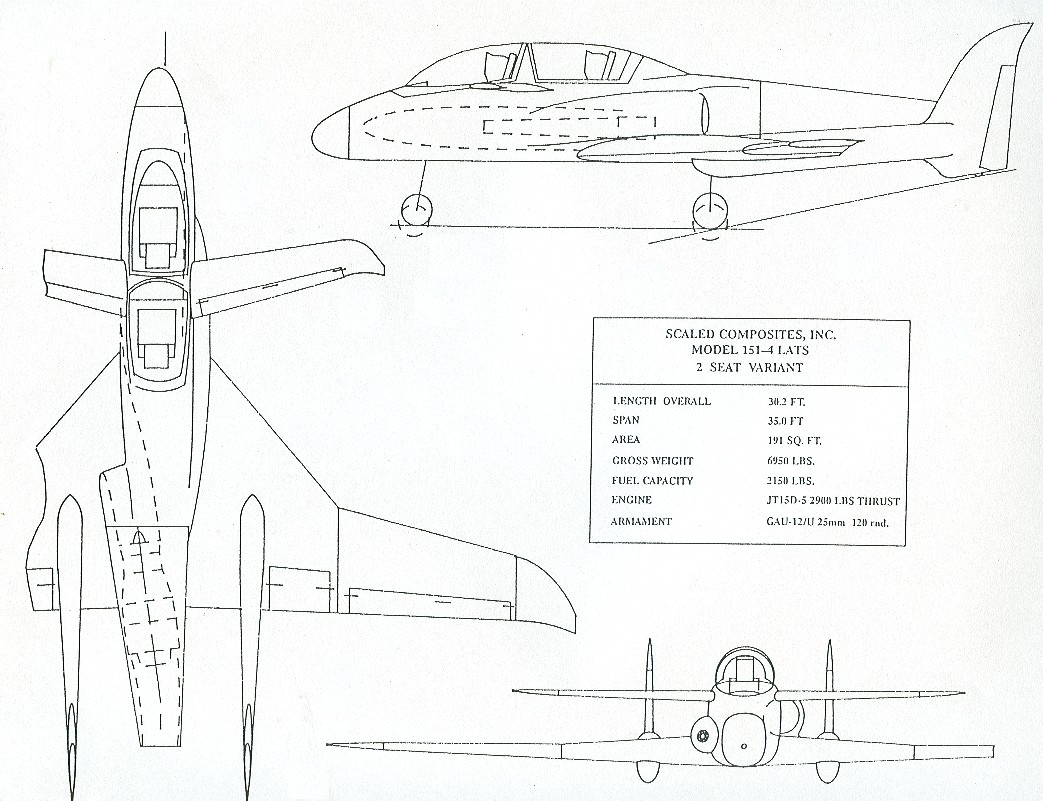
In the 125 flights and 180 hours of flight test since February 1990, the ARES has largely met its performance and handling qualities goals. Its asymmetric fuselage has thus far shown good results in shielding the inlet from gun gas ingestion, while providing good inlet performance. The composite structure has been very reliable, and easily accommodates the average 7000-lb recoil and 100 psi muzzle blast pressure of the GAU-12/U cannon.
The canard configuration has allowed departure-free flying qualities, particularly during aggressive maneuvering and terrain flight, and the overall handling qualities have proven to be good.
While the detailed assessments of specific mission suitability are far beyond the scope of our testing, it appears that the ARES concept offers suitable performance and flying qualities for a variety of military tasks, including anti-helicopter, light anti-armor, border patrol, and other low-intensity conflict missions, and, in 2-seat form, forward air control and tactics and proficiency training.
References
1. Kreutz, Jim, "Low Cost Battlefield Attack Aircraft", Sky Blue Aviation, 1989, unpublished.
2. Hoerner, Dr. Sighard F., Fluid Dynamic Drag, published by the author, 1965, pp. 3-1 8, Figure 35.
FEEDBACK!
"On your topic of low-cost CAS aircraft, I once read an article about such a plane that you may find interesting. It was designed by Sadler Aircraft Industries. It had a rear-mounted engine with a pusher propeller. It had a twin-boom arrangement with straight wings and was powered by a Chevy V-6 engine. The pilot was protected in a kevlar bathtub and it had a parachute that dropped the whole plane if disabled. Look into it, it looks like a fine COIN aircraft tailor made for underdeveloped countries."
FEEDBACK!
